Rational Use of Energy in Sport Centers to Achieving Net Zero—The SAVE Project (Part B: Indoor Sports Hall)
Abstract
:1. Introduction
1.1. Background
1.2. Literature Review
1.3. Research Aim
2. The Sports Facility
3. Methodology
- collaboration with the municipal authority and the establishment of an open communication line with the staff responsible for the operation and maintenance of the facility;
- onsite inspection of the sports facility and collection of data regarding the existing conditions, including the architectural and construction elements, the systems’ properties and operation schedules, and the energy demand;
- initial computational simulation of the existing condition and calculation of annual indoor space heating and cooling load;
- calculation of the primary energy consumption to fully cover all energy end uses, including the existing active systems for indoor space conditioning, domestic hot water, and lighting;
- selection, siting, and sizing of the most technically feasible and cost-effective passive interventions, aiming primarily at the minimisation of the cooling and heating energy demand;
- second computational simulation of the sports facility’s operation in the suggested situation including the proposed passive measures and computation of the indoor space heating/cooling loads in annual operation;
- selection and sizing of the most technically feasible and cost-effective active measures for indoor space conditioning, domestic hot water production, and lighting;
- calculation of the primary energy consumption for full coverage of all energy demand with the proposed active systems;
- sizing and siting of a photovoltaic system, for the annual covering of the remaining electricity consumption;
- calculation of the annual energy savings for the retrofit scenario, the project’s total budget, and other typical key performance indicators (KPIs).
- the climatic data were sourced from the European Centre for Medium-Range Weather Forecasts (see Section 4);
- properties of the proposed new equipment and materials were retrieved from the manufacturers’ manuals and datasheets;
- thermophysical and optical properties of the building’s construction elements are either calculated or sourced from existing literature.
4. Climate Conditions—Meteorological Data
5. The Energy Performance Upgrade of the Indoor Sports Hall
5.1. Current State
5.2. Energy Consumption in the Existing Situation
- Indoor space conditioning;
- domestic hot water production;
- indoor and outdoor space lighting.
5.2.1. Indoor Space Conditioning
- hi = 10 W/m2∙K and ho = 25 W/m2∙K for air flow over horizontal surfaces and for an average wind speed of 5 m/s;
- hi = 7.7 W/m2∙K and ho = 25 W/m2∙K for air flow next to vertical surfaces and for an average wind speed of 5 m/s.
5.2.2. Domestic Hot Water Production
- is the mass flow rate of the consumed hot water;
- cp = 4.187 kJ/kg∙K the water specific heat capacity;
- Thw = 45 °C the hot water required temperature;
- Tsw the water temperature from the municipal water supply network. given by the Technical Directive 20701-1/2017 [68] (from 12.8 °C in February to 26.6 °C in August).
- During the winter period, which spans from 16 October to 14 April, the existing oil burner in the auxiliary building will be used both for indoor space heating and domestic hot water production.
- During the summer period, namely from 15 April to 15 October, the existing electrical boilers will be employed for hot water production.
5.2.3. Lighting
- Indoor lighting in the main sports hall is provided by 32 mercury floodlights and 4 halogen floodlights, with a nominal electrical power of 250 W and 400 W, respectively.
- Indoor lighting in the auxiliary building utilizes fluorescent lamps fitted in 28 outdated plastic luminaires without reflective surfaces.
- Outdoor perimeter lighting for the entire facility is supplied by 4 mercury floodlights, each with a nominal electrical power of 250 W.
5.2.4. Other Electricity Consumptions
- Three circulators for the heating hydraulic network: two with a nominal electrical input of 150 W each for the main sports hall, and one with a nominal electrical input of 100 W for the auxiliary building.
- Twenty-two (22) fans for the hydronic terminal units in the main sports hall, each with a nominal electrical input of 183 W.
- 808.8 kWh for the main sports hall heating network circulators
- 145.6 kWh for the auxiliary building heating network circulators
- 10,854.1 kWh for the hydronic units.
5.2.5. Synopsis Regarding the Energy Consumption in Existing Conditions
5.3. Proposed Energy Saving Measures
- Replacement of all existing semi-transparent polycarbonate panels from the vertical walls of the main sports hall with stone wool panels of 8 cm thickness, with a total net surface of 579.4 m2 and U-factor of 0.38 W/m2∙K.
- Installation of external insulation on all vertical opaque surfaces made of reinforced concrete or bricks using 7 cm thick stone wool sheets. The new U-factors are calculated to be 0.40 W/m2∙K for the structural parts of the opaque surfaces and 0.34 W/m2∙K for the brick walls. The total opaque area to be insulated is 471.7 m2.
- Replacement of all synthetic polyurethane panels on the main sports hall’s roof, which measures 1230 m2, with 8 cm thick stone wool panels. The new U-factor is calculated to be 0.39 W/m2∙K.
- Installation of external insulation on the auxiliary building’s roof of 304 m2 total area, using 7 cm thick stone wool sheets. The new U-factor is calculated to be 0.40 W/m2∙K.
- Replacement of all existing openings in the facility, with new ones featuring low-e technology, synthetic frames, and double glazing. The new U-factors will be 0.95 W/m2∙K for the windows and 1.2 W/m2∙K for the doors. A total of 46 windows and 5 doors will be installed, covering total areas of 44.6 m2 and 16.6 m2, respectively.
- Installation of 54 solar tubes on the main sports hall’s roof, arranged in a 6 × 9 layout, to maximize natural daylight.
- Installation of an air-to-water heat pump with a nominal capacity of 150 kWth for heating and 149 kWth for cooling for the main sports hall. This heat pump will utilize the existing hydraulic network and the 22 hydronic terminal units with a nominal capacity of 6.5 kWth each for both heating and cooling. The oil burners will be removed.
- Installation of a second air-to-water heat pump with nominal capacities of 11.2 kWth for heating and 10.0 kWth for cooling for the auxiliary building, along with a new hydraulic network and new hydronic terminal units. A total of 12 new hydronic units will be installed, with capacities ranging from 1.6 kWth to 2.7 kWth.
- Installation of a solar-combi system featuring 24 solar collectors, each with an absorber surface of 2.4 m2, and two heat storage tanks with capacities of 2000 L each. The system is supported by a third air-to-water heat pump with a nominal heating capacity of 23 kWth. The layout of this system is depicted in Figure 9. The solar collectors will be installed on the ground, on the south side of the facility, with an inclination of 30° relative to the horizontal plane and a southern orientation to maximize the annual captured solar radiation.
- Replacement of all existing lamps and luminaires for both indoor and outdoor lighting with new fixtures featuring reflective surfaces and LED technology. A total of 4 outdoor luminaires and 47 indoor luminaires in the auxiliary building will be replaced, while 40 new LED floodlights will be installed in the main sports hall. The total installed lighting power will be reduced from 18.4 kW to 8.4 kW, a decrease of 54.4%.
- Lastly, a photovoltaic plant will be installed on the roof of the main sports hall to offset the remaining electricity consumption. The use of diesel oil will be completely eliminated with the removal of the existing diesel oil burners.
- Finally, a photovoltaic plant will be installed on the main sports hall’s roof to compensate for the remaining electricity consumption. The use of diesel oil will be totally eliminated with the removal of the diesel oil burners.
5.4. Energy Consumption with the Proposed Energy-Upgrading Interventions
5.4.1. Indoor Space Conditioning
5.4.2. Domestic Hot Water Production
- if Tsol > Tst, the circulator of the solar collectors’ primary closed loop turns on, and heat transfer takes place from the solar collectors to the heat storage tanks;
- if Tsol ≤ Tst, then the heat produced by the solar collectors cannot be transferred to the heat storage tanks, and the circulator of the solar collectors’ primary loop remains off;
- if Tst < Thw, then the back-up unit (the heat pump) is turned on;
- where:
- Tsol: the supplied water temperature from the solar collectors;
- Tst: the stored water temperature in the heat storage tanks;
- Thw: the required hot water temperature.
- the 1-year period hourly time-series of the total incident solar irradiance on the 40° inclined surface (Figure 12);
- the 1-year period hourly time-series of the heat demand for domestic hot water production (Figure 8, Section 5.2.2);
- the water-specific heat capacity (4.187 kJ/kg∙K);
- the minimum set point of the domestic hot water temperature Thw, set equal to:
- -
- from the 1st of January to the 30th of April: 40 °C
- -
- from the 1st of May to the 30th of June: 35 °C
- -
- from the 1st of July to the 15th of September: 30 °C
- -
- from the 16th of September to the 15th of November: 35 °C
- -
- from the 16th of November to the 31st of December: 40 °C;
- typical geometrical and thermo-physical features of a collective plate, flat solar collector’s model [44];
- typical geometrical and thermo-physical features of a heat storage tank with a 2000 L storage capacity (2.4 m height, 1.3 m diameter, 10 mm insulation thickness, and a total U-factor of 0.22 W/m2∙K).
- ΝSC: the solar collectors’ total number in the system;
- CSC: the procurement cost of one solar collector, adopted to be equal to EUR 450;
- ΝSΤ: the quantity of heat storage tanks in the system, with storage capacity of 2000 L;
- CSΤ: the procurement cost of one 2000 L heat storage tank, adopted to be equal to EUR 6000;
- ESC: the annual heat demand coverage for domestic hot water production from the solar-combi system;
- ΤLP: the solar-combi system’s life span, adopted as equal to 15 years.
- the 47.6% contribution from solar collectors toward the annual heat demand;
- The complete elimination of diesel oil consumption, which is replaced by electricity.
5.4.3. Lighting
- The passive measures entail the installation of 54 solar tubes on the main sports hall’s roof, arranged in nine parallel rows along the hall’s longitudinal axis, each row containing six tubes, as illustrated in Figure 15. This figure also presents photometric results at 1 m above ground level, demonstrating natural light penetration solely through the proposed solar tubes, captured on a typical summer day at 12:00 a.m. Comparable results for a typical sunny winter day at 12:00 a.m. are shown in Figure 16. According to the Greek Directive on Building’s Energy Performance, the minimum required illuminance at 1 m height is set at 300 lux. As observed in Figure 15 and Figure 16, the proposed number and arrangement of solar tubes fulfill the lighting requirements for both sunny winter and summer days.
- With these solar tubes, it is anticipated that natural lighting will fully cover the lighting needs of the main sports hall during the day for most days of the year. This intervention is also expected to fully offset the reduction in natural lighting due to the substitution of the existing semi-transparent and energy-inefficient polycarbonate panels with opaque stone wool panels.
- Regarding active measures, practically all existing mercury and halogen floodlights in the main sports hall and outdoor areas, as well as outdated fluorescent lamps and luminaires, will be completely replaced with LED floodlights and lamps equipped with reflective surfaces. Specifically, the 32 existing mercury and 4 halogen floodlights in the main sports hall will be replaced by 40 LED floodlights, arranged in eight rows of five units each, with a nominal electrical power input of 147 W and a nominal luminous flux of 22,000 lumens. Photometric results in the main sports hall with this proposed lighting equipment are provided in Figure 17. As demonstrated in this figure, the illuminance requirements are fully met with this proposed floodlight arrangement. All photometric calculations for this section were performed using DIALux evo 11 [70].
5.4.4. Remaining Electricity Consumption—Summary of New Consumptions
5.4.5. Photovoltaic Station
- avoid the need for additional structures and weight on the building’s roof, which would be required for alternative installation inclinations and orientations;
- prevent potential shading of the solar tubes by the photovoltaic panels, as the panels are situated among these tubes;
- mitigate any impact on the building’s overall form and aesthetic quality.
5.5. Synopsis of Energy Savings and Key Performance Indicators
- Payback period and economic indices:
- It is calculated to be equal to 26.4 years, by dividing the project’s total budget (EUR 953,000) by the annually achieved economic benefit (EUR 36,051). The payback period is calculated to be relatively high. Yet, it should be stated that such high payback periods are rather usual in similar energy performance upgrade projects of buildings and other facilities, especially when passive measures are included among the proposed interventions. On the other hand, it should also be underlined that the proposed interventions do not have only an energy-saving contribution. They contribute to the renovation of a facility, prolonging its lifetime period and ensuring its structural stability. Additionally, both in general and in this specific case, they create a more comfortable and pleasant indoor environment, with excellent thermal comfort and lighting conditions, which enable the use of the facility regardless of the season and the climate conditions. Based on these remarks, the payback period in such projects should not be considered a critical decision parameter with regard to the implementation of the project or not.
- Lastly, it should also be underlined that with the proposed interventions, the hosted activities and sports and the number of the facility’s users will be sensibly increased, bringing additional income for the municipality and, practically, reducing the payback period. The annual maintenance cost will also be reduced. Although all these parameters are not known to the authors, to proceed to a more structural cost–benefit analysis, we may assume:
- current annual maintenance cost EUR 10,000;
- annual maintenance cost after the implementation of the proposed interventions: gradually varied from EUR 0 to 10,000;
- number of users in the current operation state: 150;
- number of users in the new operation state: 250;
- monthly fee per user: EUR 30;
- number of months per annum: 10;
- discount rate: 3%.
- Based on these assumptions, the annual monetary flows for the ensuing 20 years are calculated and presented in Table 20. From this data, the following key financial metrics are calculated:
- payback period: 12.9 years;
- discounted payback period: 16.6 years;
- net present value: EUR 138,690.
- It should be noted that the assumptions are only approximate and are introduced solely to facilitate a more structured cost–benefit analysis and to enable the calculation of more accurate economic indicators.
- Annual primary energy saving:
- As indicated in Table 16, the anticipated annual primary energy savings amount to 397,585 kWh, representing 100.6% compared to the existing annual primary energy consumption.
- Annual Renewable Energy Sources (RES) penetration:
- The total contribution of the suggested RES technologies to the annual energy demand coverage originates from:
- -
- the production of 40,195 kWh of electricity from the photovoltaic system, which corresponds to 116,565.5 kWh of primary energy;
- -
- the heat production of 19,692.7 kWh from the solar collectors, which corresponds to 35,804.9 kWh of primary solar radiation, assuming a typical average efficiency of 55% for the solar collectors.
- In conclusion, the total primary energy contribution from RES is calculated to be 152,370.4 kWh. The facility’s remaining electricity consumption amounts to 39,437.1 kWh, equivalent to 114,367.6 kWh of primary energy. By dividing these two primary energy amounts, the RES annual penetration in the facility is calculated at 133.2% relative to the remaining electricity consumption (before its compensation from the photovoltaic plant).
- CO2 emissions saving:
- The annual CO2 emissions saving is due to the elimination of diesel oil consumption, electricity saving, and demand compensation with the photovoltaic plant. According to the Greek Directive on Buildings’ Energy Performance [67], the following factors are introduced as specific CO2 emissions:
- -
- 0.989 kg CO2/kWh of electricity;
- -
- 0.264 kg CO2/kWh of primary energy corresponding to diesel oil consumption.
- Given the aforementioned factors, the annual CO2 emissions savings are calculated as shown in Table 21.
6. Discussion
- the reliance on diesel oil boilers for heating both the main sports hall and the auxiliary building;
- the lack of any kind of active cooling system for the main sports hall;
- the availability of only one air-to-air heat pump for the cooling of only one specific room (the administrative office) in the auxiliary building;
- the notably high U-factor values of all construction elements, which contribute to a particularly cold indoor environment in the main sports hall during winter;
- the high solar gain factor of the semi-transparent polycarbonate panels in the main sports hall, which, in combination with their large surfaces, significantly increases indoor temperatures in the summer;
- the absence of any kind of active system for generating electricity or heat from renewables;
- the use of electrical resistances and diesel oil for domestic hot water production;
- the use of ineffective lighting equipment.
7. Conclusions
Author Contributions
Funding
Data Availability Statement
Acknowledgments
Conflicts of Interest
Glossary
| Abbreviations (Alphabetically) | |
| ANN | Artificial neural network |
| ASHRAE | American Society of Heating, Refrigerating and Air-Conditioning Engineers |
| BEMS | Building energy management system |
| COP | Coefficient of performance |
| DSM | Demand-side management |
| EER | Energy efficiency ratio |
| EU | European Union |
| GHE | Geothermal heat exchangers |
| GHP | Geothermal heat pumps |
| HVAC | Heating, ventilation, and air conditioning |
| KPIs | Key performance indicators |
| NESOI | New Energy Solutions Optimized for Islands |
| PPR | Polypropylene |
| RES | Renewable energy sources |
| RHC | Radiant heating and cooling |
| RUE | Rational use of energy |
| SAVE | Sustainable Actions for Viable Energy |
| TFM | Transfer function method |
| VRV | Variable refrigerant volume |
| W-SAHP | Water solar-assisted heat pump |
| ZEB | Zero emission building |
| Nomenclature (In Order of Appearance) | |
| Tamb | the ambient temperature |
| U | the thermal heat transfer factor (the so-called U-factor) (in W/m2∙K) |
| hc | the heat convection factor for ambient air horizontal flow with average velocity of 5 m/s (10 W/m2∙Κ) |
| hrw | the heat radiation factor |
| cp | the water specific heat capacity (4.187 kJ/kg∙K) |
| Tsw | the water temperature in the water supply network |
| hfg | the specific latent heat of water (2441.7 kJ/kg at 25 °C) |
| dj | the thickness of the structural material j of the opaque constructive element |
| kj | the thermal conductivity factor of the structural material j of the opaque constructive element |
| hi | the heat transfer factor from the inner space and towards the outer space ho (or conversely in summer) |
| ho | the heat transfer factor towards the outer space (or conversely in summer) |
| ACH | air changes per hour |
| Tin | the indoor space temperature |
| the domestic hot water consumed mass flow rate | |
| Thw | the hot water required temperature |
| Pel | the electrical power consumption in the heat pump |
| Qh | the indoor space heating load |
| hw | the thermal convection factor of still water, equal to 50 W/(m2∙K) |
| Qc | the indoor space cooling load |
| Tsol | the supplied water temperature from the solar collectors |
| Tst | the stored water temperature in the heat storage tanks |
| Thw | the required hot water temperature |
| ΝSC | the solar collectors’ total number in the system |
| CSC | the procurement price of one solar collector, adopted equal to EUR 450 |
| ΝSΤ | the heat storage tanks’ number in the system, with storage capacity of 2000 L |
| CSΤ | the procurement price of one 2000 L heat storage tank, adopted equal to EUR 6000 |
| ESC | the annual heat demand coverage for domestic hot water production from the solar-combi system |
| ΤLP | the solar-combi system’s life period, adopted equal to 15 years |
| cth | the heat production specific cost from the solar-combi system |
References
- Katsaprakakis, D.A.; Papadakis, N.; Giannopoulou, E.; Yiannakoudakis, Y.; Zidianakis, G.; Kalogerakis, M.; Katzagiannakis, G.; Dakanali, E.; Stavrakakis, G.M.; Kartalidis, A. Rational Use of Energy in Sports Centres to Achieve Net Zero: The SAVE Project (Part A). Energies 2023, 16, 4040. [Google Scholar] [CrossRef]
- Directive (EU) 2018/844 of the European Parliament and of the Council of 30 May 2018 Amending Directive 2010/31/EU on the Energy Performance of Buildings and Directive 2012/27/EU on Energy Efficiency. Volume 156. 2018. Available online: https://Eur-Lex.Europa.Eu/Legal-Content/EN/TXT/?Uri=uriserv%3AOJ.L_.2018.156.01.0075.01.ENG (accessed on 14 February 2023).
- Directive 2012/27/EU of the European Parliament and of the Council of 25 October 2012 on Energy Efficiency, Amending Directives 2009/125/EC and 2010/30/EU and Repealing Directives 2004/8/EC and 2006/32/EC (Text with EEA Relevance)Text with EEA Relevance. 2012. Volume EUR-Lex-02012L0027-20230504-EN. Available online: https://eur-lex.europa.eu/LexUriServ/LexUriServ.do?uri=OJ:L:2012:315:0001:0056:en:PDF (accessed on 14 February 2023).
- Law 4122/2013. Official Governmental Gazette 42A’/19-2-2013. Energy Performance of Buildings—Harmonization with the Directive 2010/31/EU of the European Parliament and the Council and Other Clauses. Available online: https://www.kodiko.gr/nomothesia/document/70937/nomos-4122-2013 (accessed on 18 February 2023).
- International Energy Agency (IEA). Buildings—Analysis. Available online: https://www.iea.org/reports/buildings (accessed on 18 February 2023).
- Vakiloroaya, V.; Samali, B.; Fakhar, A.; Pishghadam, K. A Review of Different Strategies for HVAC Energy Saving. Energy Convers. Manag. 2014, 77, 738–754. [Google Scholar] [CrossRef]
- Weerasinghe, A.S.; Ramachandra, T. Economic Sustainability of Green Buildings: A Comparative Analysis of Green vs Non-Green. Built Environ. Proj. Asset Manag. 2018, 8, 528–543. [Google Scholar] [CrossRef]
- Baek, S.G. Plan for the Sustainability of Public Buildings through the Energy Efficiency Certification System: Case Study of Public Sports Facilities, Korea. Buildings 2021, 11, 589. [Google Scholar] [CrossRef]
- Li, X.; Shen, C.; Yu, C.W.F. Building Energy Efficiency: Passive Technology or Active Technology? Indoor Built Environ. 2017, 26, 729–732. [Google Scholar] [CrossRef]
- Balaras, C.A.; Grossman, G.; Henning, H.-M.; Infante Ferreira, C.A.; Podesser, E.; Wang, L.; Wiemken, E. Solar Air Conditioning in Europe—An Overview. Renew. Sustain. Energy Rev. 2007, 11, 299–314. [Google Scholar] [CrossRef]
- Pérez-Lombard, L.; Ortiz, J.; Pout, C. A Review on Buildings Energy Consumption Information. Energy Build. 2008, 40, 394–398. [Google Scholar] [CrossRef]
- D’Agostino, D.; Cuniberti, B.; Bertoldi, P. Energy Consumption and Efficiency Technology Measures in European Non-Residential Buildings. Energy Build. 2017, 153, 72–86. [Google Scholar] [CrossRef]
- Clark, D. What Colour Is Your Building? Measuring and Reducing the Energy and Carbon Footprint of Buildings; RIBA Publishing: London, UK, 2019; ISBN 978-0-429-34773-3. [Google Scholar]
- Yezioro, A.; Capeluto, I.G. Energy Rating of Buildings to Promote Energy-Conscious Design in Israel. Buildings 2021, 11, 59. [Google Scholar] [CrossRef]
- Khan, M.A.; Wang, C.C.; Lee, C.L. A Framework for Developing Green Building Rating Tools Based on Pakistan’s Local Context. Buildings 2021, 11, 202. [Google Scholar] [CrossRef]
- Zero Energy Building Certification System. Available online: https://zeb.energy.or.kr/BC/BC00/BC00_01_001.do (accessed on 21 February 2023).
- Teni, M.; Čulo, K.; Krstić, H. Renovation of Public Buildings towards NZEB: A Case Study of a Nursing Home. Buildings 2019, 9, 153. [Google Scholar] [CrossRef]
- Garcia, J.F.; Kranzl, L. Ambition Levels of Nearly Zero Energy Buildings (NZEB) Definitions: An Approach for Cross-Country Comparison. Buildings 2018, 8, 143. [Google Scholar] [CrossRef]
- Topriska, E.; Kolokotroni, M.; Melandri, D.; McGuiness, S.; Ceclan, A.; Christoforidis, G.C.; Fazio, V.; Hadjipanayi, M.; Hendrick, P.; Kacarska, M. The Social, Educational, and Market Scenario for NZEB in Europe. Buildings 2018, 8, 51. [Google Scholar] [CrossRef]
- Azaza, M.; Eskilsson, A.; Wallin, F. Energy Flow Mapping and Key Performance Indicators for Energy Efficiency Support: A Case Study a Sports Facility. Energy Procedia 2019, 158, 4350–4356. [Google Scholar] [CrossRef]
- Mayernik, J. Buildings Energy Data Book; US Department of Energy: Washington, DC, USA, 2015.
- EU Building Stock Observatory—Data Europa EU. Available online: https://data.europa.eu/data/datasets/building-stock-observatory?locale=en (accessed on 10 August 2023).
- TM46: Energy Benchmarks|CIBSE. Available online: https://www.cibse.org/knowledge-research/knowledge-portal/tm46-energy-benchmarks (accessed on 19 February 2023).
- ECG 78 Energy Use in Sports and Recreation Buildings, Building Research Energy Conservation Support Unit—Publication Index|NBS. Available online: https://www.thenbs.com/PublicationIndex/documents/details?Pub=BRECSU&DocID=285163 (accessed on 19 February 2023).
- Trianti-Stourna, E.; Spyropoulou, K.; Theofylaktos, C.; Droutsa, K.; Balaras, C.A.; Santamouris, M.; Asimakopoulos, D.N.; Lazaropoulou, G.; Papanikolaou, N. Energy Conservation Strategies for Sports Centers: Part A. Sports Halls. Energy Build. 1998, 27, 109–122. [Google Scholar] [CrossRef]
- Hjortling, C.; Björk, F.; Berg, M.; Klintberg, T.A. Energy Mapping of Existing Building Stock in Sweden—Analysis of Data from Energy Performance Certificates. Energy Build. 2017, 153, 341–355. [Google Scholar] [CrossRef]
- Stengård, L.; Berling-Agståhl, L. Energistatistik för Flerbostadshus 2008. Energy Statistics for Multi-Dwelling Buildings in 2008; Swedish Energy Authority: Örebro, Sweden, 2009.
- Griffiths, A.J.; Bowen, P.J.; Brinkworth, B.J.; Morgan, I.R.; Howarth, A. Energy Consumption in Leisure Centres—A Comparative Study. Energy Environ. 1997, 8, 207–225. [Google Scholar] [CrossRef]
- Katsaprakakis, D.A.; Dakanali, I.; Zidianakis, G.; Yiannakoudakis, Y.; Psarras, N.; Kanouras, S. Potential on Energy Performance Upgrade of National Stadiums: A Case Study for the Pancretan Stadium, Crete, Greece. Appl. Sci. 2019, 9, 1544. [Google Scholar] [CrossRef]
- Sadineni, S.B.; Madala, S.; Boehm, R.F. Passive Building Energy Savings: A Review of Building Envelope Components. Renew. Sustain. Energy Rev. 2011, 15, 3617–3631. [Google Scholar] [CrossRef]
- Katsaprakakis, D.A.; Zidianakis, G.; Yiannakoudakis, Y.; Manioudakis, E.; Dakanali, I.; Kanouras, S. Working on Buildings’ Energy Performance Upgrade in Mediterranean Climate. Energies 2020, 13, 2159. [Google Scholar] [CrossRef]
- Dudzińska, A. Efficiency of Solar Shading Devices to Improve Thermal Comfort in a Sports Hall. Energies 2021, 14, 3535. [Google Scholar] [CrossRef]
- Efthymiou, E.N.; Yfanti, S.; Kyriakarakos, G.; Zervas, P.L.; Langouranis, P.; Terzis, K.; Stavrakakis, G.M. A Practical Methodology for Building a Municipality-Led Renewable Energy Community: A Photovoltaics-Based Case Study for the Municipality of Hersonissos in Crete, Greece. Sustainability 2022, 14, 12935. [Google Scholar] [CrossRef]
- Stavrakakis, G.M.; Tomazinakis, N.M.; Markatos, N.C. Modified ‘closure’ constants of the Standard k-ε turbulence model for the prediction of wind-induced natural ventilation. Build. Serv. Eng. Res. Technol. 2012, 33, 241–261. [Google Scholar] [CrossRef]
- Stavrakakis, G.M.; Katsaprakakis, D.A.; Damasiotis, M. Basic Principles, Most Common Computational Tools, and Capabilities for Building Energy and Urban Microclimate Simulations. Energies 2021, 14, 6707. [Google Scholar] [CrossRef]
- Rhee, K.-N.; Kim, K.W. A 50 Year Review of Basic and Applied Research in Radiant Heating and Cooling Systems for the Built Environment. Build. Environ. 2015, 91, 166–190. [Google Scholar] [CrossRef]
- Chua, K.J.; Chou, S.K.; Yang, W.M. Advances in Heat Pump Systems: A Review. Appl. Energy 2010, 87, 3611–3624. [Google Scholar] [CrossRef]
- Tagliafico, L.A.; Scarpa, F.; Tagliafico, G.; Valsuani, F. An Approach to Energy Saving Assessment of Solar Assisted Heat Pumps for Swimming Pool Water Heating. Energy Build. 2012, 55, 833–840. [Google Scholar] [CrossRef]
- Chow, T.T.; Bai, Y.; Fong, K.F.; Lin, Z. Analysis of a Solar Assisted Heat Pump System for Indoor Swimming Pool Water and Space Heating. Appl. Energy 2012, 100, 309–317. [Google Scholar] [CrossRef]
- Omeiza, L.A.; Abid, M.; Dhanasekaran, A.; Subramanian, Y.; Raj, V.; Kozak, K.; Mamudu, U.; Azad, A.K. Application of solar thermal collectors for energy consumption in public buildings—An updated technical review. J. Eng. Res. 2023. [Google Scholar] [CrossRef]
- Weiss, W.; Spörk-Dür, M. Global Market Development and Trends in 2019 Detailed Market Data 2018; IEA: Gleisdorf, Austria, 2020.
- Olfian, H.; Ajarostaghi, S.S.M.; Ebrahimnataj, M. Development on evacuated tube solar collectors: A review of the last decade results of using nanofluids. Sol. Energy 2020, 211, 265–282. [Google Scholar] [CrossRef]
- Katsaprakakis, D.A. Comparison of Swimming Pools Alternative Passive and Active Heating Systems Based on Renewable Energy Sources in Southern Europe. Energy 2015, 81, 738–753. [Google Scholar] [CrossRef]
- Katsaprakakis, D.A. Computational Simulation and Dimensioning of Solar-Combi Systems for Large-Size Sports Facilities: A Case Study for the Pancretan Stadium, Crete, Greece. Energies 2020, 13, 2285. [Google Scholar] [CrossRef]
- Orejón-Sánchez, R.D.; Hermoso-Orzáez, M.J.; Gago-Calderón, A. LED Lighting Installations in Professional Stadiums: Energy Efficiency, Visual Comfort, and Requirements of 4K TV Broadcast. Sustainability 2020, 12, 7684. [Google Scholar] [CrossRef]
- Fantozzi, F.; Leccese, F.; Salvadori, G.; Rocca, M.; Garofalo, M. LED Lighting for Indoor Sports Facilities: Can Its Use Be Considered as Sustainable Solution from a Techno-Economic Standpoint? Sustainability 2016, 8, 618. [Google Scholar] [CrossRef]
- Fei, J.; Su, Z.; Yao, Y.; Fei, C.; Shamel, A. Investigation and 3E (Economic, Environmental and Energy) Analysis of a Combined Heat and Power System Based on Renewable Energies for Supply Energy of Sport Facilities. IET Renew. Power Gener. 2023. [Google Scholar] [CrossRef]
- Artuso, P.; Santiangeli, A. Energy Solutions for Sports Facilities. Int. J. Hydrogen Energy 2008, 33, 3182–3187. [Google Scholar] [CrossRef]
- Balaras, C.A.; Gaglia, A.G.; Georgopoulou, E.; Mirasgedis, S.; Sarafidis, Y.; Lalas, D.P. European Residential Buildings and Empirical Assessment of the Hellenic Building Stock, Energy Consumption, Emissions and Potential Energy Savings. Build. Environ. 2007, 42, 1298–1314. [Google Scholar] [CrossRef]
- Ma, Z.; Cooper, P.; Daly, D.; Ledo, L. Existing Building Retrofits: Methodology and State-of-the-Art. Energy Build. 2012, 55, 889–902. [Google Scholar] [CrossRef]
- Luddeni, G.; Krarti, M.; Pernigotto, G.; Gasparella, A. An Analysis Methodology for Large-Scale Deep Energy Retrofits of Existing Building Stocks: Case Study of the Italian Office Building. Sustain. Cities Soc. 2018, 41, 296–311. [Google Scholar] [CrossRef]
- Ascione, F.; Bianco, N.; Stasio, C.D.; Mauro, G.M.; Vanoli, G.P. Addressing Large-Scale Energy Retrofit of a Building Stock via Representative Building Samples: Public and Private Perspectives. Sustainability 2017, 9, 940. [Google Scholar] [CrossRef]
- Gabrielli, L.; Ruggeri, A.G. Optimal Design in Energy Retrofit Interventions on Building Stocks: A Decision Support System. In Appraisal and Valuation: Contemporary Issues and New Frontiers; Morano, P., Oppio, A., Rosato, P., Sdino, L., Tajani, F., Eds.; Green Energy and Technology; Springer International Publishing: Cham, Switzerland, 2021; pp. 231–248. ISBN 978-3-030-49579-4. [Google Scholar]
- Tuominen, P.; Forsström, J.; Honkatukia, J. Economic Effects of Energy Efficiency Improvements in the Finnish Building Stock. Energy Policy 2013, 52, 181–189. [Google Scholar] [CrossRef]
- Gabrielli, L.; Ruggeri, A.G.; Scarpa, M. Automatic Energy Demand Assessment in Low-Carbon Investments: A Neural Network Approach for Building Portfolios. J. Eur. Real Estate Res. 2020, 13, 357–385. [Google Scholar] [CrossRef]
- Swan, L.G.; Ugursal, V.I. Modeling of End-Use Energy Consumption in the Residential Sector: A Review of Modeling Techniques. Renew. Sustain. Energy Rev. 2009, 13, 1819–1835. [Google Scholar] [CrossRef]
- Pittarello, M.; Scarpa, M.; Ruggeri, A.G.; Gabrielli, L.; Schibuola, L. Artificial Neural Networks to Optimize Zero Energy Building (ZEB) Projects from the Early Design Stages. Appl. Sci. 2021, 11, 5377. [Google Scholar] [CrossRef]
- New Energy Solutions Optimized for Islands (NESOI) The “Sustainable Actions for Viable Energy” (SAVE) Project. Available online: https://www.nesoi.eu/content/save-greece (accessed on 14 February 2023).
- Minoan Energy Community The SAVE Project of NESOI. Available online: https://minoanenergy.com/en/%cf%84%ce%bf-%ce%ad%cf%81%ce%b3%ce%bf-save-%cf%84%ce%bf%cf%85-nesoi/ (accessed on 14 February 2023).
- European Commission Clean Energy for EU Islands. Island Gamechanger Award. Available online: https://clean-energy-islands.ec.europa.eu/assistance/island-gamechanger-award (accessed on 14 February 2023).
- European Centre for Medium-Range Weather Forecasts (ECMWF) ERA5 from the Copernicus Climate Change Service (C3S) Climate Date Store. ERA5 Hourly Data on Single Levels from 1959 to Present. Available online: https://cds.climate.copernicus.eu/#!/search?text=ERA5&type=dataset (accessed on 14 February 2023).
- Kreider, J.; Rabl, A.; Curtiss, P. Heating and Cooling of Buildings, 3rd ed.; CRC Press: Boca Raton, FL, USA, 2017. [Google Scholar]
- Spitler, J.D. Load Calculation Applications Method, 2nd ed.; ASHRAE Editions: Atlanta, GA, USA, 2014. [Google Scholar]
- Kteniadakis, M. Heat Transfer Applications, 2nd ed.; Ziti Editions: Athens, Greece, 2021. [Google Scholar]
- 2009 ASHRAE Handbook—Fundamentals (SI Edition); American Society of Heating, Refrigerating and Air-Conditioning Engineers, Inc.: Atlanta, GA, USA, 2009.
- Stavrakakis, G.M.; Stamou, A.I.; Markatos, N.C. Evaluation of Thermal Comfort in Indoor Environments Using Computational Fluid Dynamics (CFD). In Indoor Work and Living Environments: Health, Safety and Performance; Harris, R.G., Moore, D.P., Eds.; Nova Science Publishers Inc.: Hauppauge, NY, USA, 2009; Volume 2009, pp. 97–166. [Google Scholar]
- Official Hellenic Governmental Gazette. Directive on Buildings’ Energy Performance—(Greek) 2367Β’/12-7-2017; Official Hellenic Governmental Gazette: Athens, Greece, 2017.
- Technical Chamber of Greece Technical. Directive 20701-1/2017: Analytical National Specifications for the Buildings’ Energy Performance Evaluation and the Issuance of the Energy Performance Certificate; Technical Chamber of Greece: Athens, Greece, 2017. [Google Scholar]
- Katsaprakakis, D.A.; Zidianakis, G. Optimized Dimensioning and Operation Automation for a Solar-Combi System for Indoor Space Heating. A Case Study for a School Building in Crete. Energies 2019, 12, 177. [Google Scholar] [CrossRef]
- DIALux Evo—Online Photometric Tool. Available online: https://www.dialux.com/en-GB/ (accessed on 14 February 2023).
- Fragkiadakis, I. Photovoltaic Systems, 4th ed.; Ziti Editions: Athens, Greece, 2019. [Google Scholar]
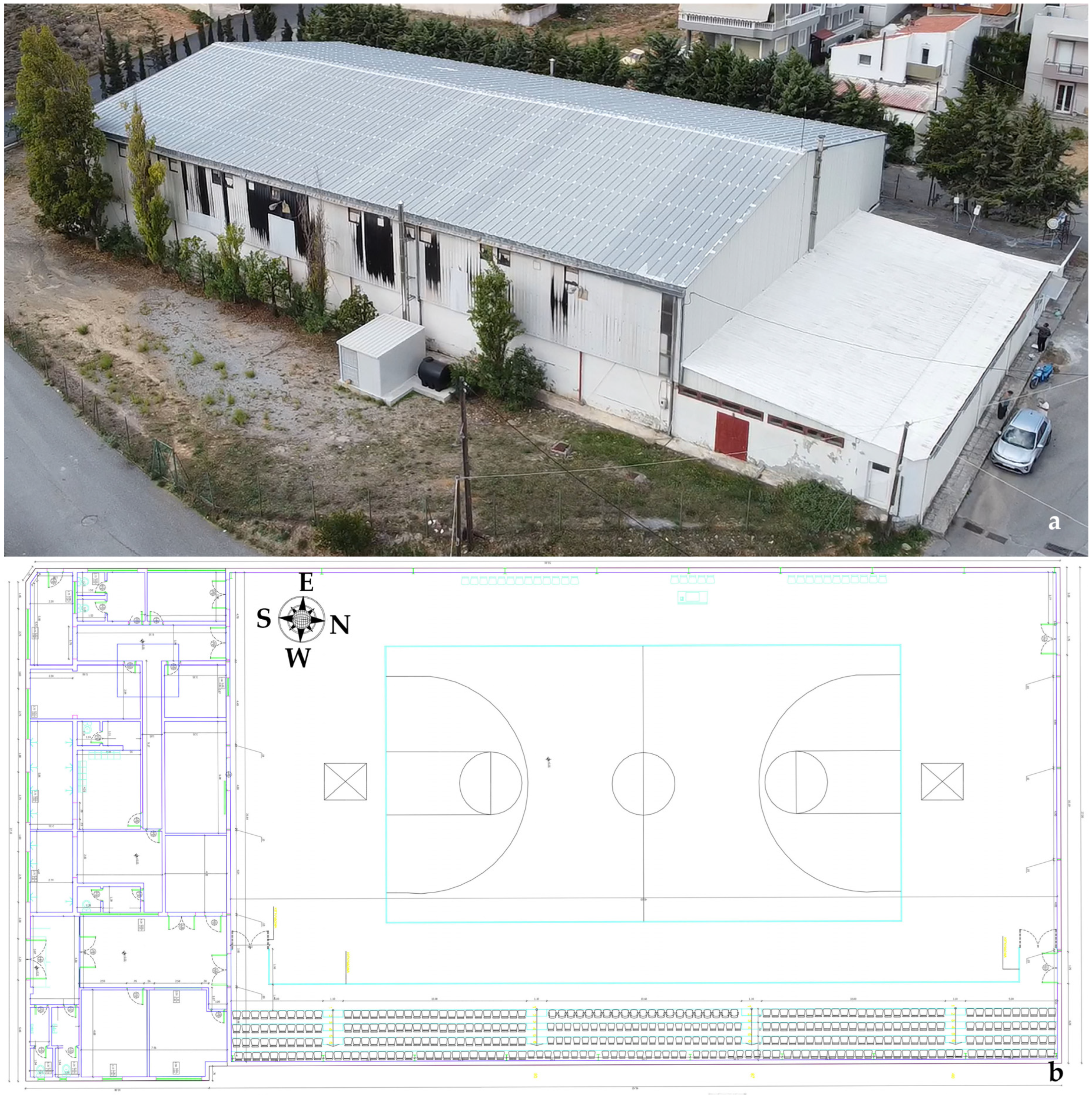
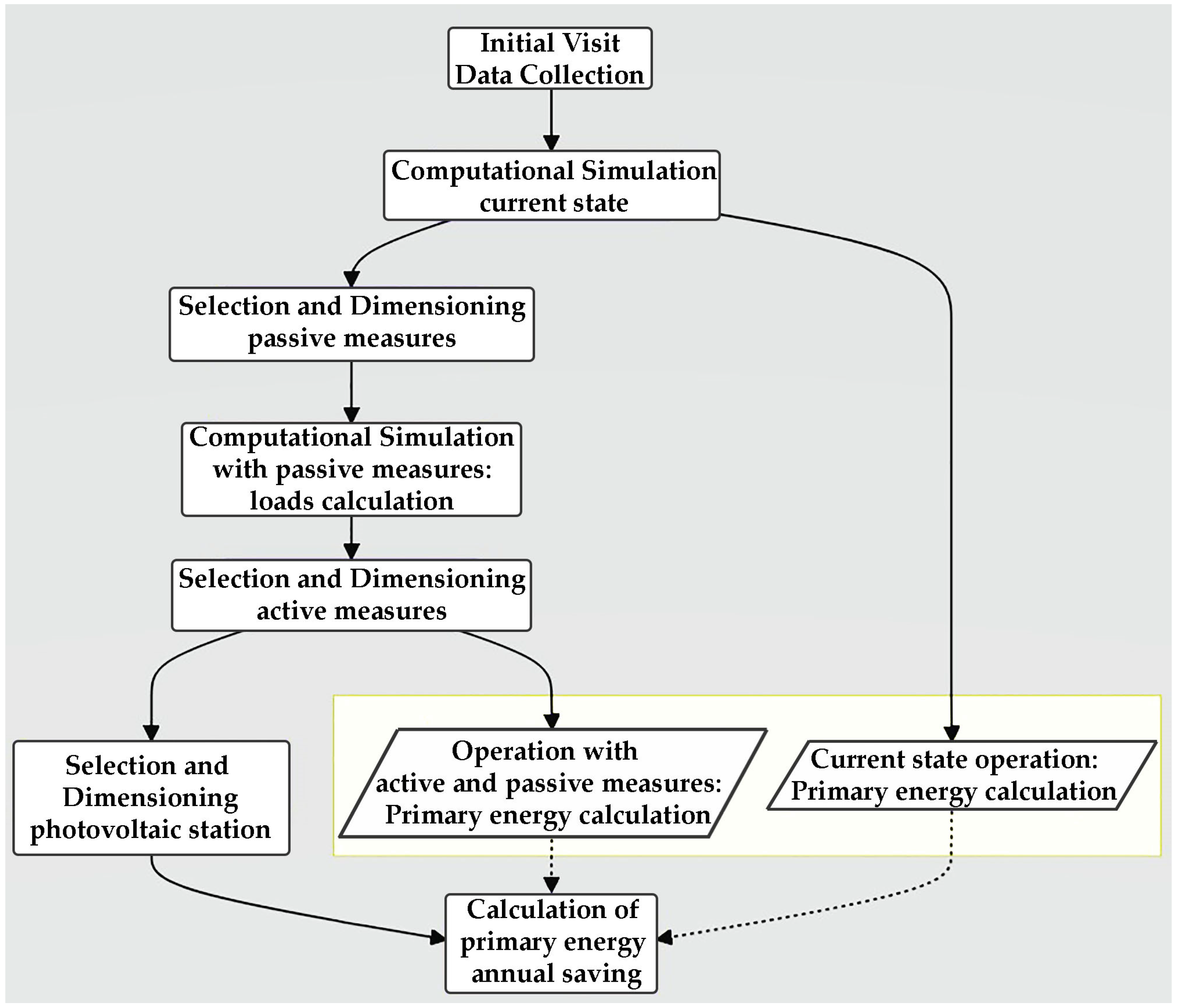
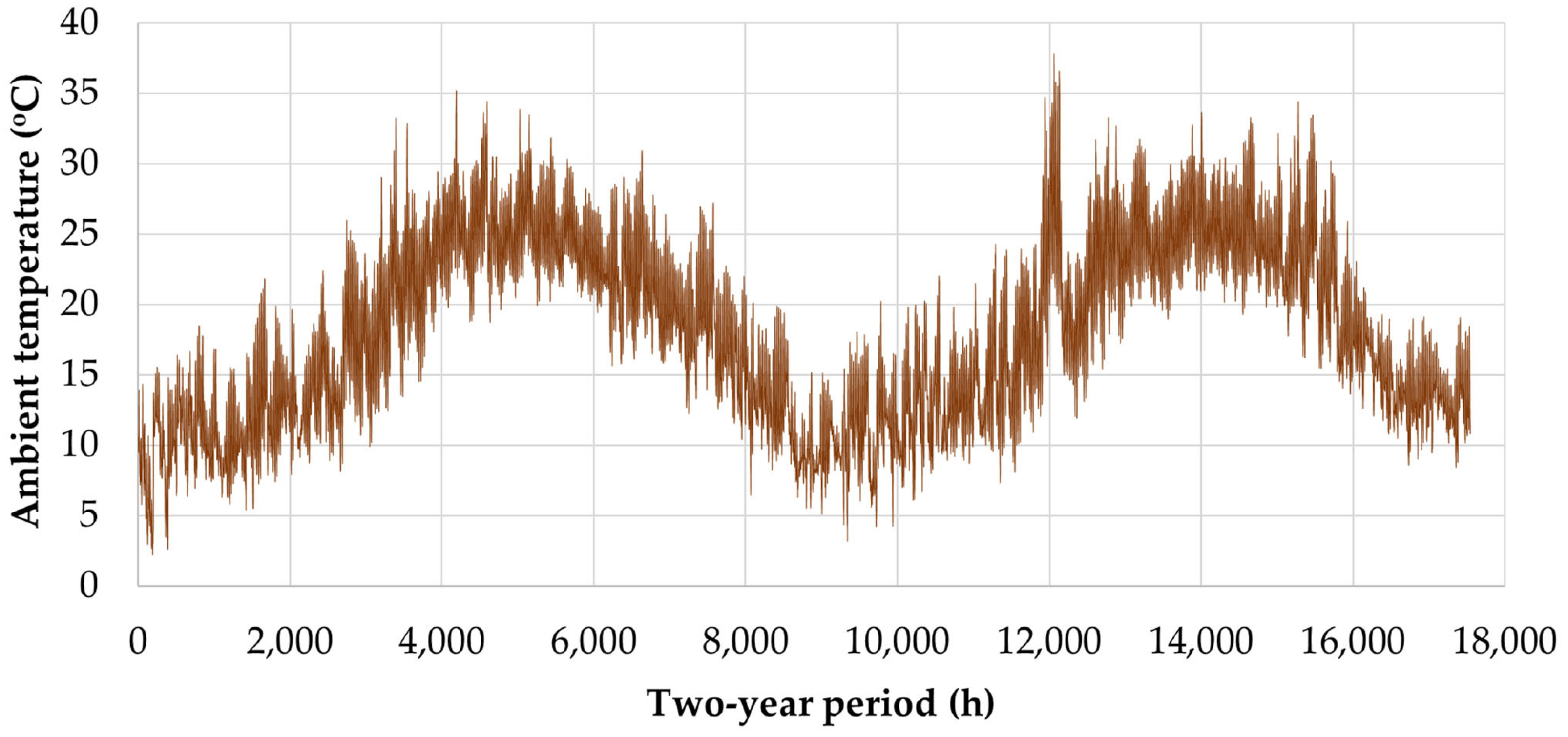

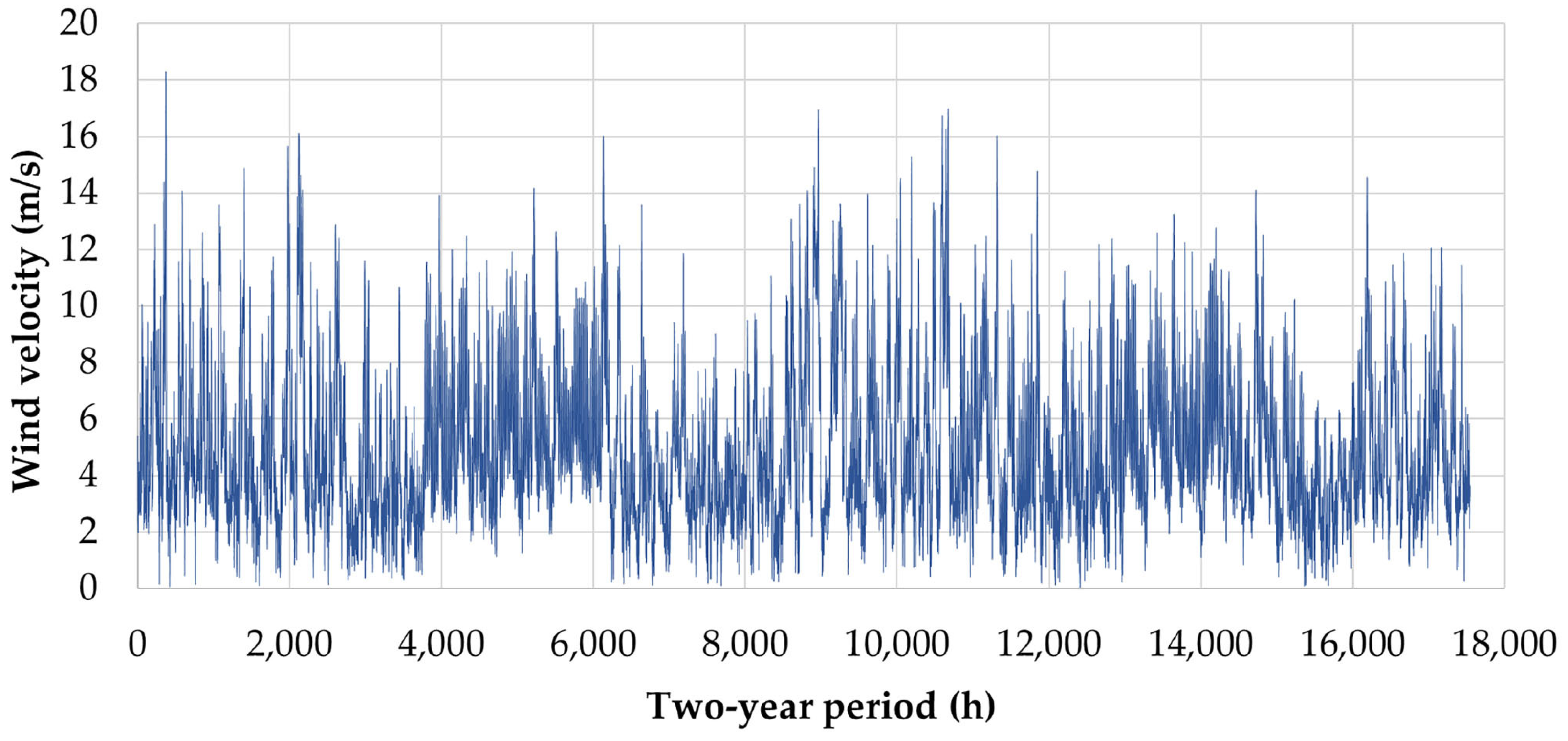
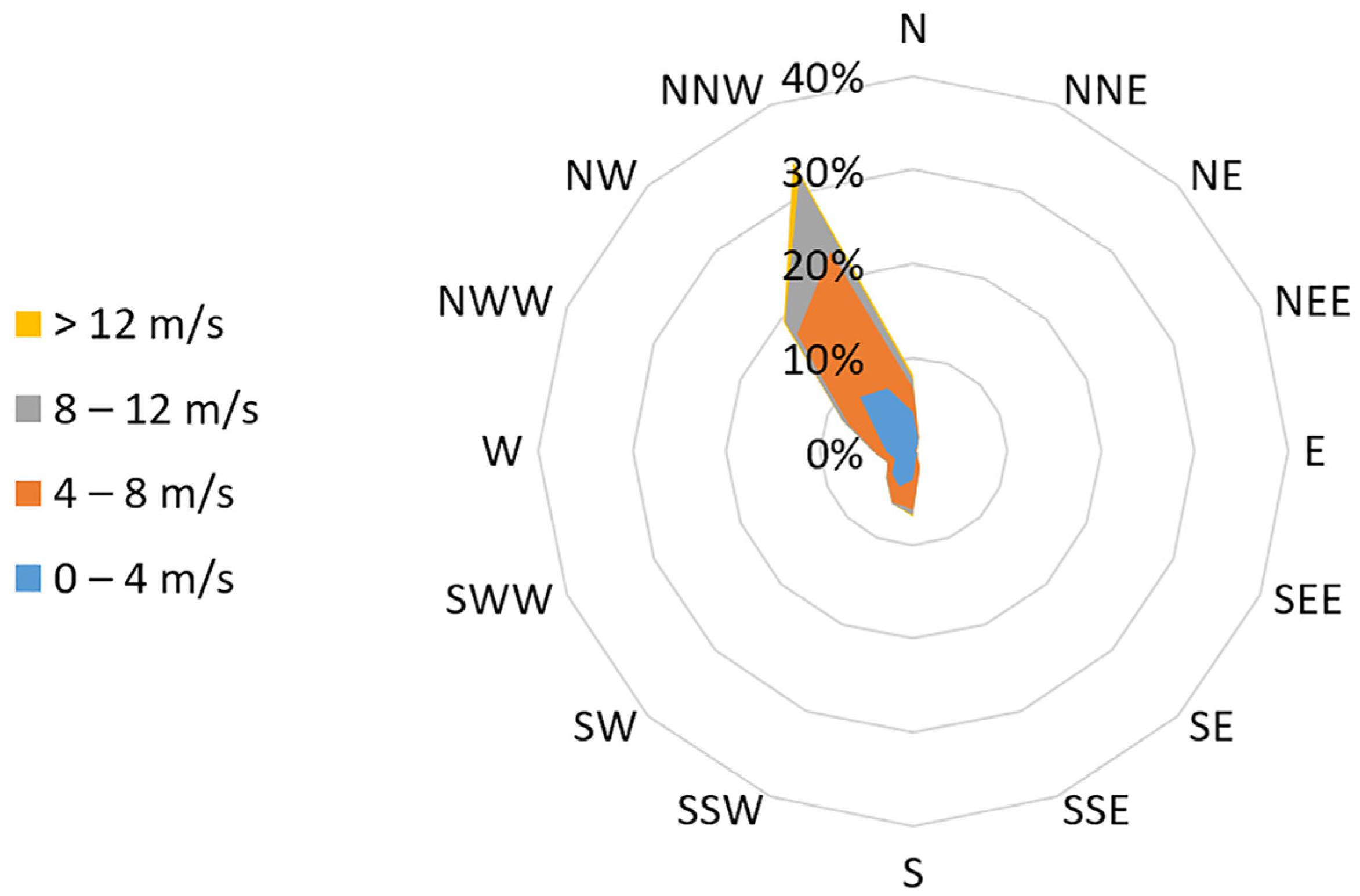
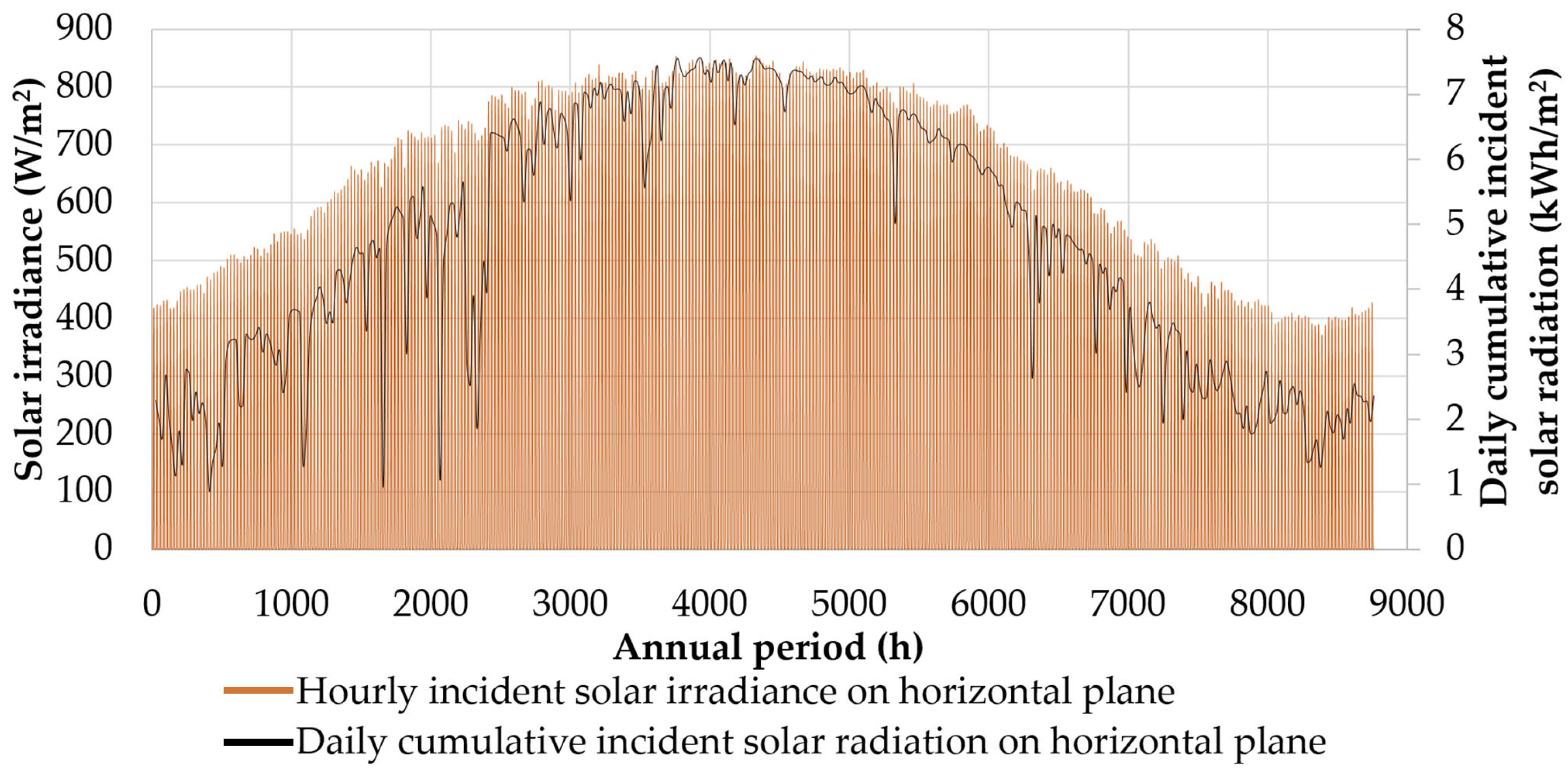

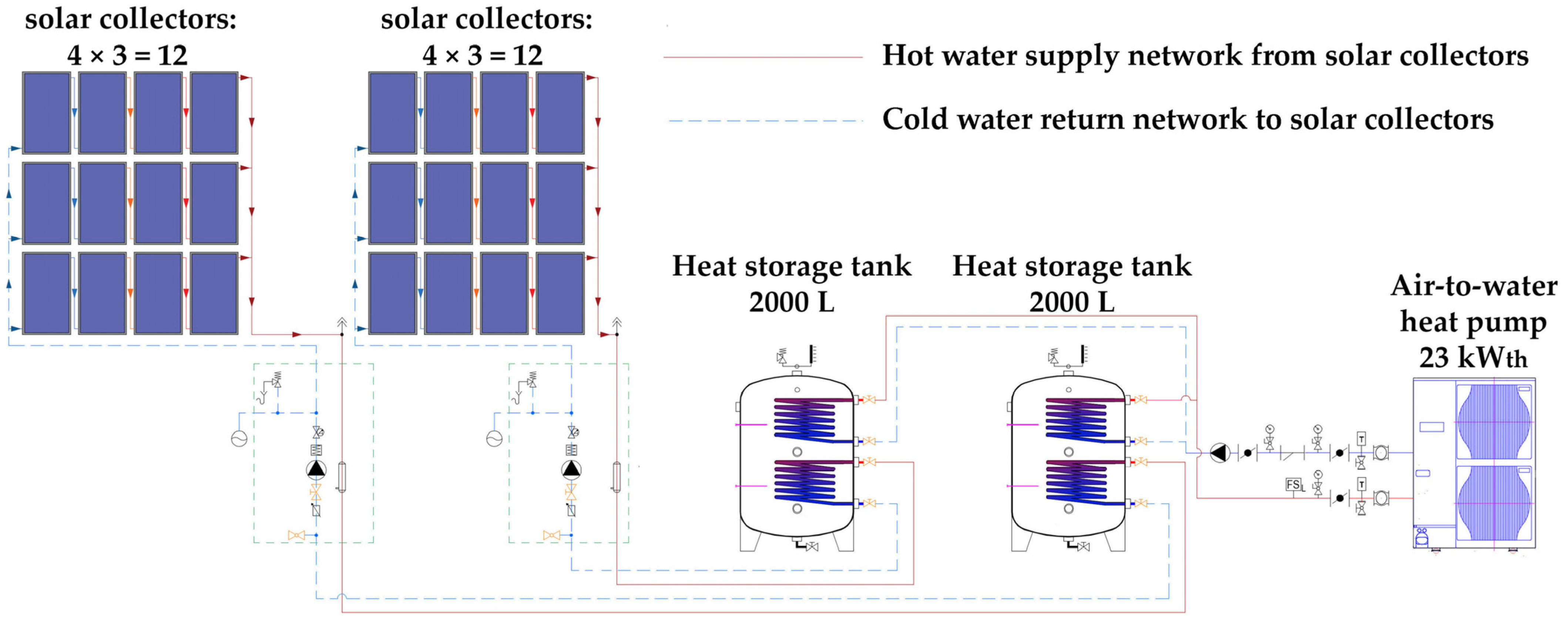
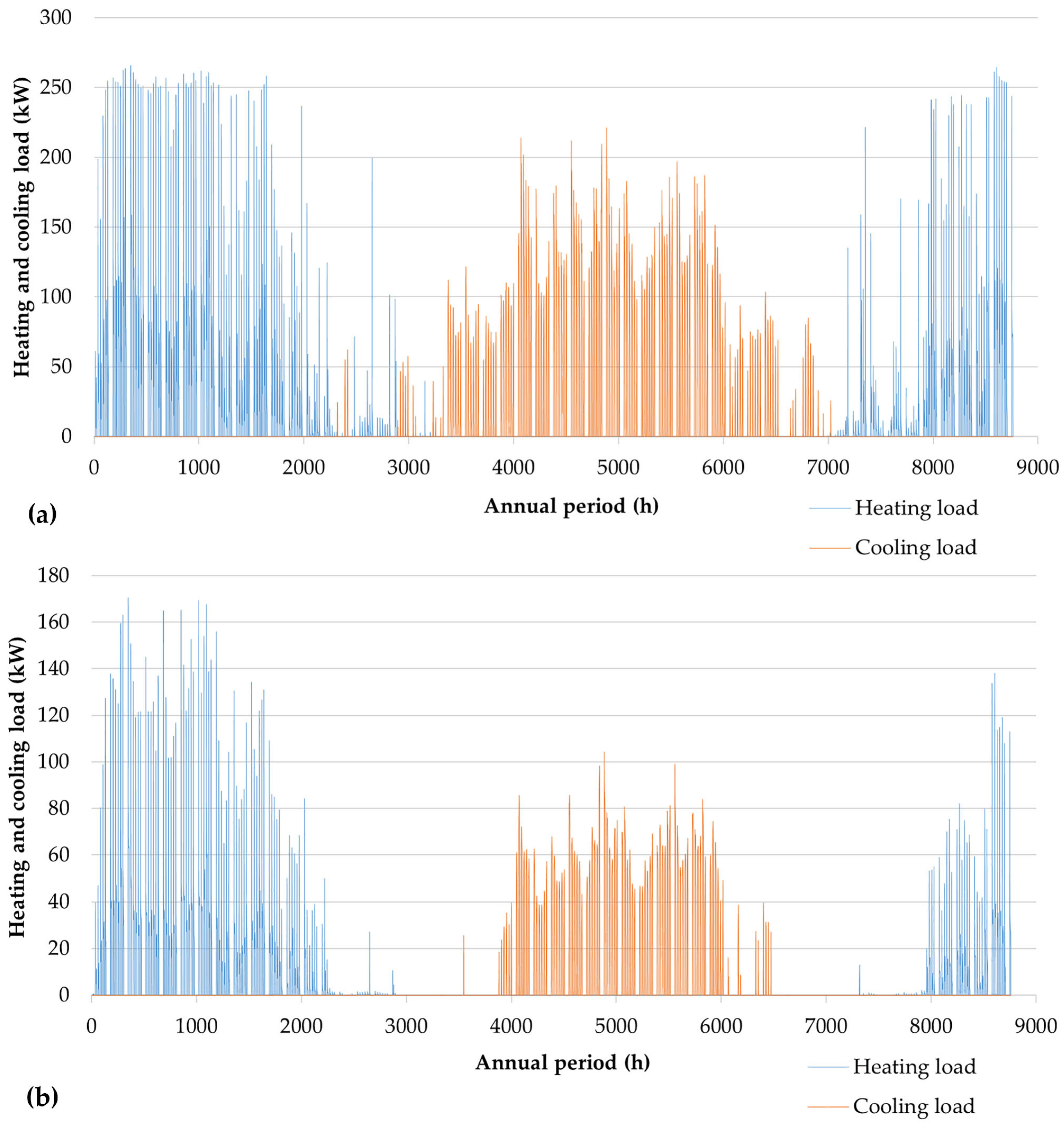
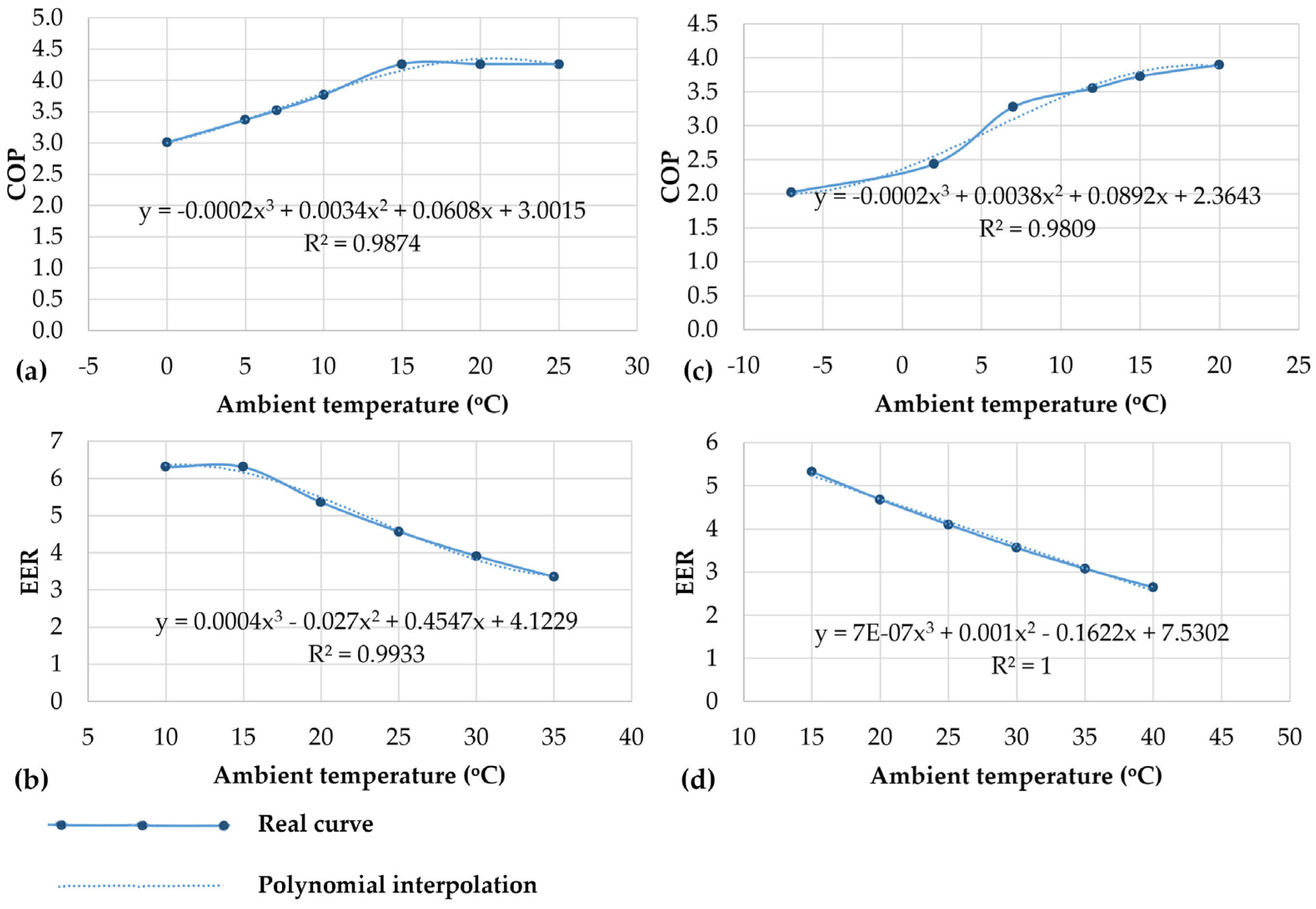

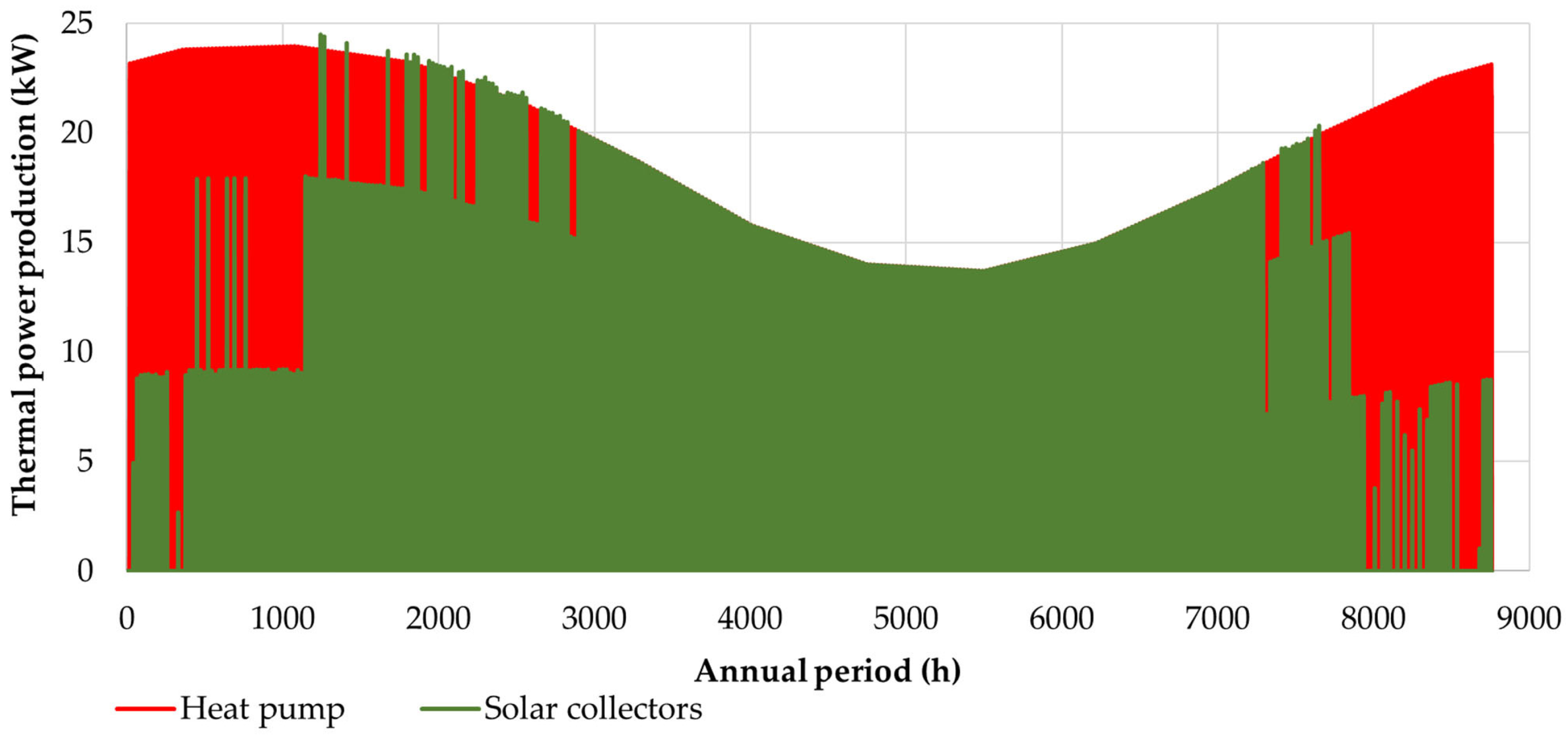
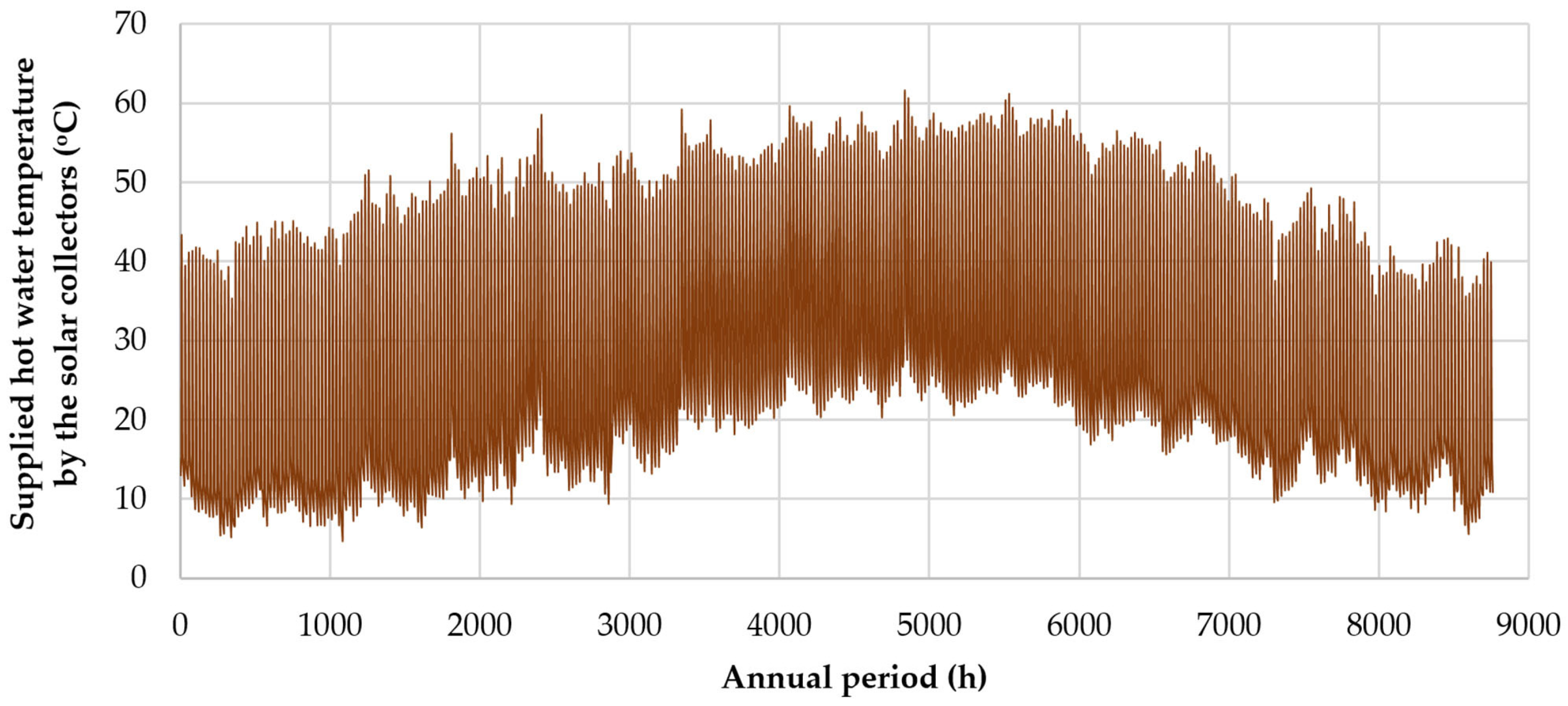

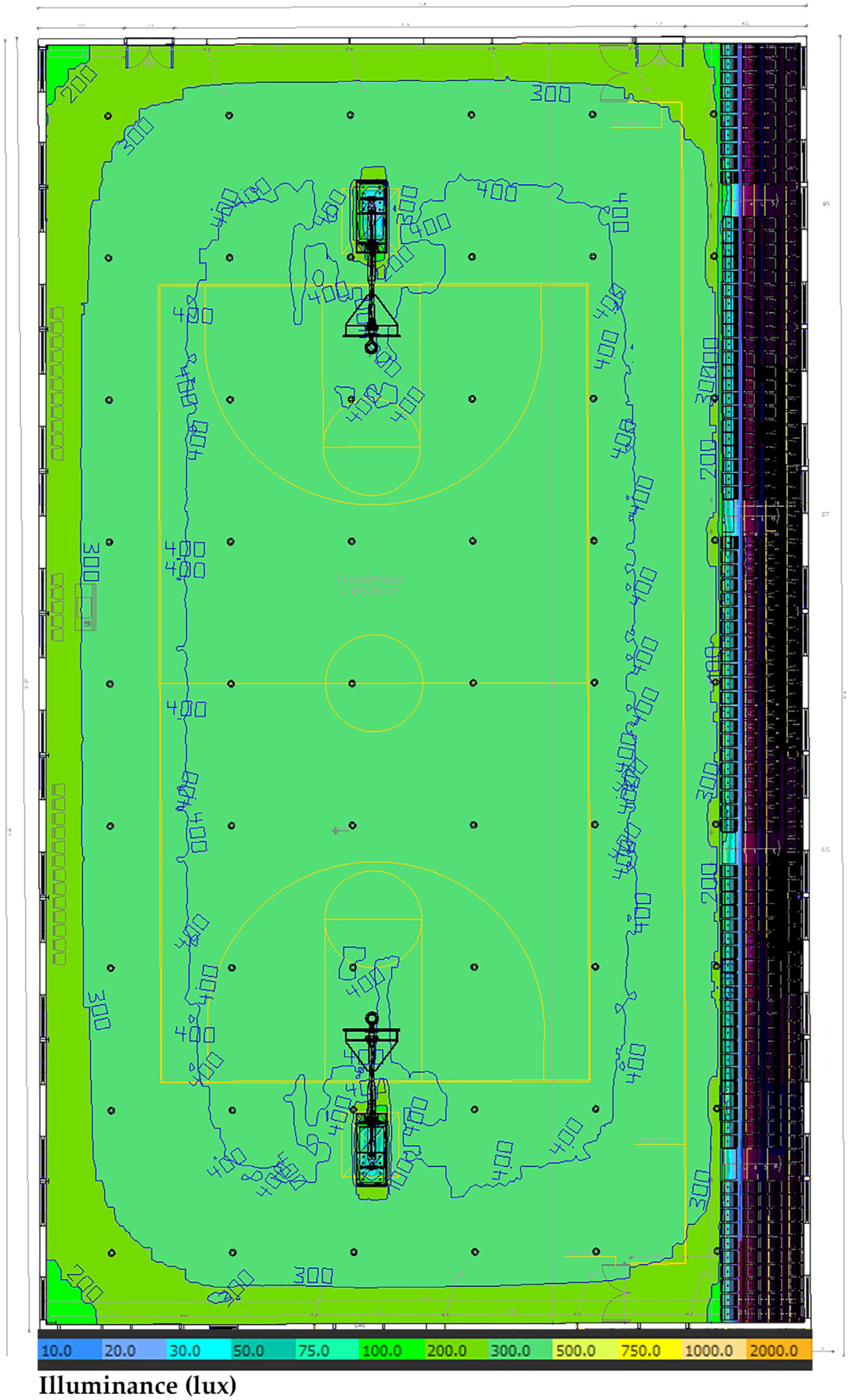

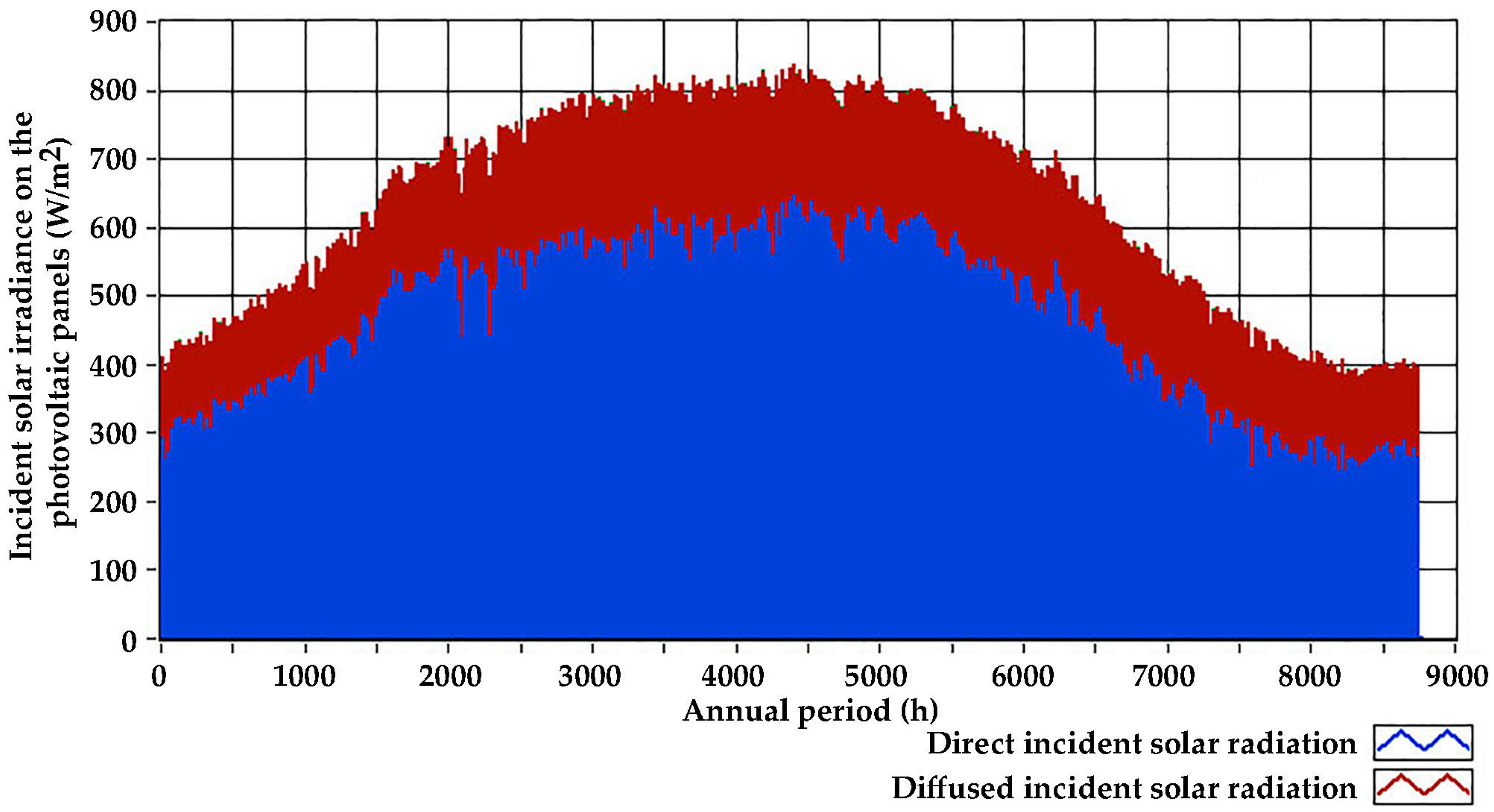
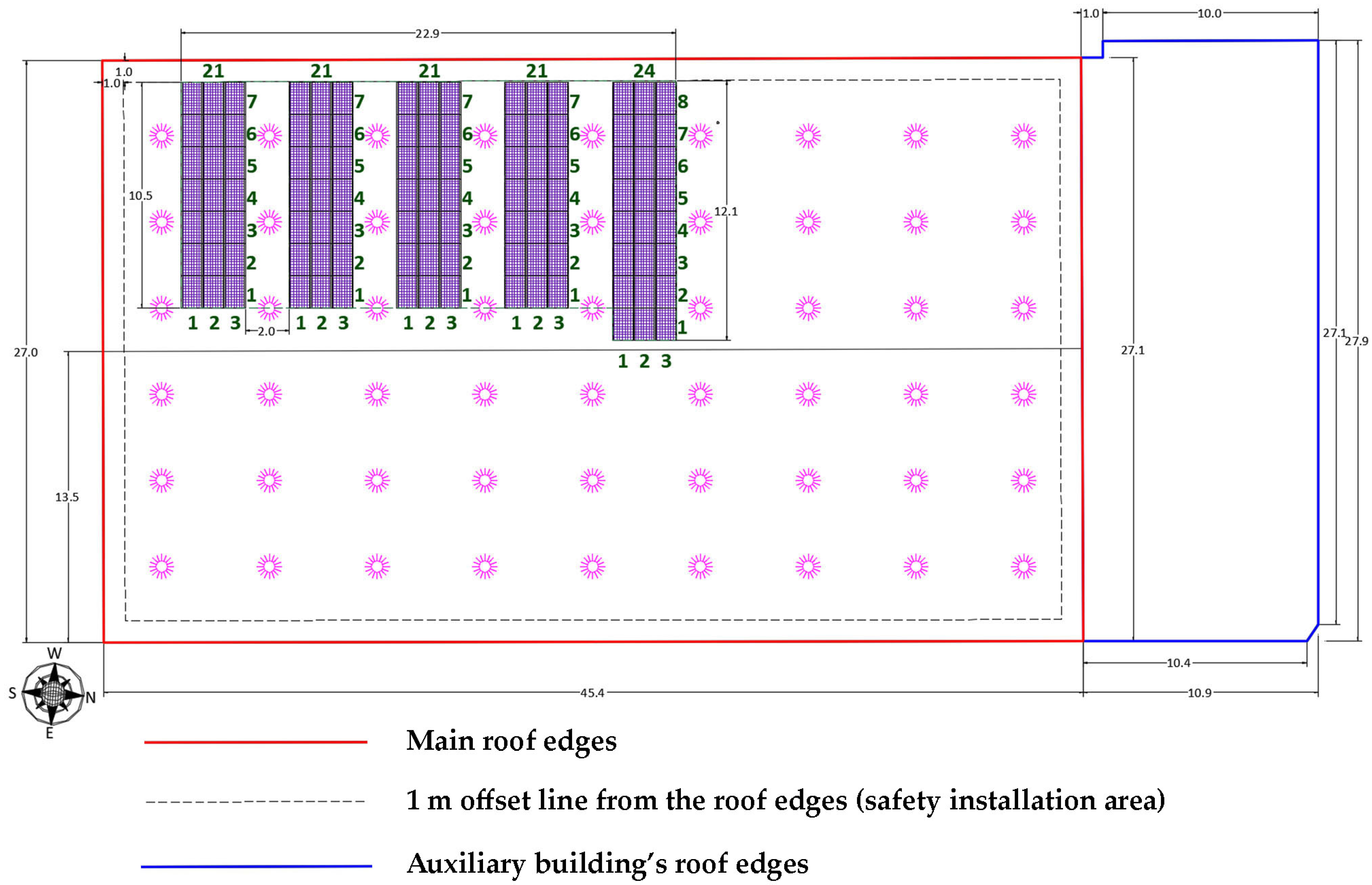
| Energy Need | Requirement | Share | Comments |
|---|---|---|---|
| Space heating | High | 40–60% | Due to large spaces, in cold climate |
| Space cooling | Medium | 10–25% | Due to large spaces, in hot climate |
| Lighting | Medium | 10–20% | Evening activities and large indoor courts |
| Water heating | Medium | 10–20% | Showers, pools, and saunas |
| Ventilation and air handling | Low | 1–5% | Requirement for fresh air in workout areas |
| Refrigeration | Low | 0–5% | For cafeterias or snack areas |
| Equipment | Low | 1–5% | Gym equipment, scoreboards, sound systems |
| Elevators and escalators | Low | 0–5% | If multi-storied |
| Computing and office needs | Very low | 0–1% | For administrative areas. |
| Source | CIBSE Energy Benchmark (TM46: 2008) [23] | ECON 78 (2001) [24] | |
|---|---|---|---|
| Description | Sports Center | Local Dry Sports Center | |
| Electricity (kWh/m2) | Good | 64 | |
| Typical | 95 | 105 | |
| Gas (kWh/m2) | Good | 158 | |
| Typical | 330 | 343 | |
| Energy | Diesel Oil | Electricity |
|---|---|---|
| Final heat demand (kWh) | 79,144.6 | 101,981.9 |
| Annual consumption (L/kWh) | 11,845.5 | 28,993.8 |
| Primary energy consumption (kWh) | 121,416.8 | 28,993.8 |
| Total primary energy consumption (kWh) | 217,640.5 | |
| Energy | Diesel Oil | Electricity |
|---|---|---|
| Final heat demand (kWh) | 23,829.6 | 17,497.7 |
| Annual consumption (L/kWh) | 3262.9 | 19,388.1 |
| Primary energy consumption (kWh) | 36,789.5 | 56,225.4 |
| Total primary energy consumption (kWh) | 93,014.9 | |
| Lighting Use/Power/Consumption | Installed Electrical Power (kW) | Electricity Consumption (kWh) |
|---|---|---|
| Outdoor perimeter floodlights | 1.25 | 4627.6 |
| Main indoor sports hall | 12.86 | 11,313.9 |
| Auxiliary building | 3.91 | 1467.7 |
| Total installed power | 18.02 | |
| Total electricity consumption | 17,409.2 | |
| Total primary energy consumption | 50,486.7 |
| Final Energy Use | Diesel Oil (L) | Electricity (kWh) | Primary Energy | |
|---|---|---|---|---|
| (kWh) | (%) | |||
| Indoor space heating | 11,845.5 | 0.0 | 133,558.0 | 33.8 |
| Indoor space cooling | 0.0 | 28,993.8 | 84,082.0 | 21.3 |
| Hot water production | 3262.9 | 19,388.1 | 93,014.7 | 23.5 |
| Lighting | 0.0 | 17,409.2 | 50,486.7 | 12.8 |
| Circulators and fans | 0.0 | 11,808.5 | 34,244.7 | 8.7 |
| Total | 15,108.4 | 77,599.6 | 395,386.1 | 100.0 |
| Structural Element | U-Factor (W/m2∙K) | Structural Element | U-Factor (W/m2∙K) |
|---|---|---|---|
| Main sports hall vertical surface: stone wool 8 cm panels | 0.38 | Auxiliary building vertical surface: brick walls with 7 cm stone wool insulation sheet | 0.34 |
| Main sports hall vertical surface: reinforced concrete with 7 cm stone wool insulation sheet | 0.40 | Auxiliary building vertical surface: reinforced concrete with 7 cm stone wool insulation sheet | 0.0 |
| Main sports hall roof: stone wool 8 cm panels | 0.39 | Auxiliary building roof: reinforced concrete with 7 cm stone wool insulation sheet | 0.40 |
| Windows | 0.95 | Doors | 1.2 |
| Indoor Space Conditioning Mode | Annual Load | Annual Load Reduction | ||
|---|---|---|---|---|
| Existing Operation | Proposed Operation | (kWh) | (%) | |
| Heating | 79,145 | 32,154 | 46,991 | 59.4 |
| Cooling | 101,982 | 39,181 | 62,801 | 61.6 |
| Total | 181,127 | 71,335 | 109,792 | 60.6 |
| Energy | Load—Consumption | Saving | ||
|---|---|---|---|---|
| Existing Operation | Proposed Operation | (kWh) | (%) | |
| Main sports hall (thermal zone 1) | ||||
| Heating and cooling load (kWh) | 143,484.6 | 56,515.2 | 86,969.4 | 60.6 |
| Diesel oil (L) | 7928.8 | 0.0 | 7928.8 | 100.0 |
| Electricity (kWh) | 25,273.8 | 13,122.1 | 12,151.7 | 48.1 |
| Primary energy (kWh) | 162,691.2 | 38,054.1 | 124,637.1 | 76.6 |
| Auxiliary building (thermal zone 2) | ||||
| Heating and cooling load (kWh) | 37,641.9 | 14,819.7 | 22,822.2 | 60.6 |
| Diesel oil (L) | 3916.7 | 0.0 | 3916.7 | 100.0 |
| Electricity (kWh) | 3720.0 | 3871.3 | −151.3 | -4.1 |
| Primary energy (kWh) | 54,949.4 | 11,226.9 | 43,722.4 | 79.6 |
| All indoor space | ||||
| Heating and cooling load (kWh) | 181,126.5 | 71,334.8 | 109,791.7 | 60.6 |
| Diesel oil (L) | 11,845.5 | 0.0 | 11,845.5 | 100.0 |
| Electricity (kWh) | 28,993.8 | 16,993.4 | 12,000.4 | 41.4 |
| Primary energy (kWh) | 217,640.5 | 49,281.0 | 168,359.5 | 77.4 |
| Solar Radiation | Surface Inclination with Regard to the Horizontal Plane | ||||||||
|---|---|---|---|---|---|---|---|---|---|
| 20° | 25° | 30° | 35° | 40° | 45° | 50° | 55° | 60° | |
| Annually cumulative incident solar radiation (kWh/m2) | |||||||||
| Direct | 1060 | 1078 | 1088 | 1089 | 1083 | 1068 | 1045 | 1014 | 975 |
| Diffused | 696 | 684 | 670 | 653 | 634 | 613 | 590 | 566 | 539 |
| Reflected | 13 | 20 | 29 | 39 | 51 | 64 | 78 | 93 | 109 |
| Total | 1769 | 1783 | 1787 | 1782 | 1768 | 1744 | 1712 | 1672 | 1623 |
| Cumulative incident solar radiation from 15 October to 15 March (kWh/m2) | |||||||||
| Direct | 320 | 340 | 357 | 371 | 382 | 390 | 396 | 398 | 397 |
| Diffused | 203 | 200 | 196 | 191 | 185 | 179 | 172 | 165 | 157 |
| Reflected | 4 | 6 | 8 | 11 | 14 | 17 | 21 | 25 | 29 |
| Total | 527 | 545 | 560 | 572 | 581 | 586 | 589 | 588 | 584 |
| Collectors’ Number | Tanks’ Number | Initial Heat Production from Solar Collectors (kWh) | Heat Storage (kWh) | Rejected Heat Percentage (%) | Heat Coverage from Collectors (kWh) | Heat Demand Coverage Percentage from Collectors (%) | Collectors-Tanks Cost (EUR) | Heat Production Specific Cost (EUR/kWh) |
|---|---|---|---|---|---|---|---|---|
| 12 | 1 | 31,399.4 | 13,247.6 | 57.8 | 9658.6 | 23.4 | 11,400 | 0.0787 |
| 16 | 1 | 39,826.9 | 15,161.7 | 61.9 | 11,100.7 | 26.9 | 13,200 | 0.0793 |
| 16 | 2 | 39,826.9 | 23,533.6 | 40.9 | 16,230.2 | 39.3 | 19,200 | 0.0789 |
| 20 | 2 | 47,899.2 | 26,699.0 | 44.3 | 18,506.2 | 44.8 | 21,000 | 0.0757 |
| 24 | 2 | 55,796.6 | 28,368.0 | 49.2 | 19,692.7 | 47.6 | 22,800 | 0.0772 |
| 24 | 3 | 55,796.6 | 34,285.2 | 38.6 | 21,846.9 | 52.9 | 28,800 | 0.0879 |
| 28 | 2 | 63,572.3 | 29,844.8 | 53.1 | 20,764.6 | 50.2 | 24,600 | 0.0790 |
| 28 | 3 | 63,572.3 | 36,496.9 | 42.6 | 23,354.8 | 56.5 | 30,600 | 0.0873 |
| 32 | 3 | 71,276.3 | 38,098.0 | 46.5 | 24,418.2 | 59.1 | 32,400 | 0.0885 |
| 36 | 3 | 78,941.3 | 39,571.9 | 49.9 | 25,449.0 | 61.6 | 34,200 | 0.0896 |
| 40 | 3 | 86,579.5 | 40,661.9 | 53.0 | 26,166.5 | 63.3 | 36,000 | 0.0917 |
| 40 | 4 | 86,579.5 | 46,808.9 | 45.9 | 27,129.1 | 65.6 | 42,000 | 0.1032 |
| Energy | Load—Consumption | Saving | ||
|---|---|---|---|---|
| Existing Operation | Proposed Operation | (kWh) | (%) | |
| Heat demand for hot water production (kWh) | 41,327.3 | 41,327.3 | 0.0 | 0.0 |
| Diesel oil (L) | 3262.9 | 0.0 | 3262.9 | 100.0 |
| Electricity (kWh) | 19,388.1 | 7323.4 | 12,064.7 | 62.2 |
| Primary energy (kWh) | 93,014.9 | 21,237.8 | 71,777.1 | 77.2 |
| Existing Operation | Proposed Operation | Power Drop | Electricity Saving | |||||
|---|---|---|---|---|---|---|---|---|
| Power (W) | Electricity (kWh) | Power (W) | Electricity (kWh) | (W) | (%) | (kWh) | (%) | |
| Outdoor perimeter lighting | 1648 | 4627.6 | 500 | 1334.9 | 1148 | 69.7 | 3292.7 | 71.2 |
| Main sports hall lighting | 12,864 | 11,313.9 | 5880 | 5171.5 | 6984 | 54.3 | 6142.4 | 54.3 |
| Auxiliary building indoor lighting | 3914 | 1467.7 | 2028 | 760.5 | 1886 | 48.2 | 707.2 | 48.2 |
| Total | 18,426 | 17,409.2 | 8408 | 7266.9 | 10,018 | 54.4 | 10,142.3 | 58.3 |
| Circulators of the Indoor Space Conditioning Hydraulic Network | |||
|---|---|---|---|
| Main Sports Hall | Auxiliary Building | Total | |
| Nominal electrical power input (W) | 81.7 | 143.0 | |
| Annual operating time (h) | 1738 | 1317 | |
| Annual electricity consumption (kWh) | 142.0 | 188.3 | 330.3 |
| Hydronic Units Fans | |||
| Main Sports Hall | Auxiliary Building | Total | |
| Nominal electrical power input (W) | 4026 | 306 | |
| Annual operating time (h) | 1738 | 1317 | |
| Annual electricity consumption (kWh) | 6997.2 | 403.0 | 7400.2 |
| Circulators of the Domestic Hot Water Distribution Hydraulic Network | |||
| Solar Collectors | Heat Pump | Total | |
| Nominal electrical power input (W) | 49 | 81.7 | |
| Annual operating time (h) | 1289 | 731 | |
| Annual electricity consumption (kWh) | 63.2 | 59.7 | 122.9 |
| Energy Use | Electricity Consumption (kWh) |
|---|---|
| Indoor space conditioning | 16,994 |
| Hot water production | 7323 |
| Lighting | 7267 |
| Circulators of the conditioning system | 330 |
| Hydronic units’ fans | 7400 |
| Circulators of the hot water production system | 123 |
| Total | 39,437 |
| Load/Energy Use | Load/Primary Energy Consumption (kWh) | Saving | ||
|---|---|---|---|---|
| Existing Operation | Proposed Operation | (kWh) | (%) | |
| Indoor space conditioning load | 181,127 | 71,335 | 109,792 | 60.6 |
| Primary energy for indoor space conditioning | 217,640.5 | 49,281.0 | 168,359.5 | 77.4 |
| Primary energy for domestic hot water production | 93,014.9 | 21,237.8 | 71,777.1 | 77.2 |
| Primary energy for lighting | 50,486.7 | 21,074.0 | 29,412.7 | 58.3 |
| Primary energy in circulators and fans | 34,244.7 | 22,774.9 | 11,469.8 | 33.5 |
| Photovoltaic plant primary energy production | 0 | −116,565.5 | 116,565.5 | - |
| Total annual primary energy consumption | 395,387 | −2198 | 397,585 | 100.6 |
| Energy Sources | Consumption (L or kWh) | Annual Saving | ||
|---|---|---|---|---|
| Existing Operation | Proposed Operation | (L or kWh) | (%) | |
| Diesel oil | 15,108 | 0 | 15,108 | 100.0 |
| Electricity | 77,600 | 39,437 | 38,163 | 49.2 |
| Budget Component | Cost (€) |
|---|---|
| Insulation and stone wool panels | 299,495 |
| Installation of new openings | 35,697 |
| Indoor space active conditioning systems | 226,654 |
| Solar-combi system | 101,970 |
| Natural and artificial lighting interventions | 123,195 |
| Building energy management system (BEMS) | 33,656 |
| Reactive power compensation panel | 4487 |
| Photovoltaic plant | 127,846 |
| Total | 953,000 |
| Energy Source | Procurement Price (€/kWh or €/L) | Existing Theoretical Operation | New Expected Operation | Cost Saving | |||
|---|---|---|---|---|---|---|---|
| Annual Consumption (kWh or L) | Annual Procurement Cost (EUR) | Annual Consumption (kWh or L) | Annual Procurement Cost (EUR) | (EUR) | (%) | ||
| Electricity | 0.25 | 77,600 | 19,400 | 39,437 | 1479 | 17,921 | 92.4 |
| Diesel oil | 1.2 | 15,108 | 18,130 | 0 | 0 | 18,130 | 100.0 |
| Total | 37,530.0 | 1479 | 36,051 | 96.1 | |||
| Year | Current Revenues (EUR) | Current Energy Procurement Cost (EUR) | Current Maintenance Cost (EUR) | New Revenues (EUR) | New Energy Procurement Cost (EUR) | New Maintenance Cost (EUR) | Annual Net Monetary Saving (EUR) | Discounted Annual Net Monetary Saving (EUR) | Aggregated Monetary Saving (EUR) | Discounted Aggregated Monetary Saving (EUR) |
|---|---|---|---|---|---|---|---|---|---|---|
| 1 | 45,000 | 37,530 | 10,000 | 75,000 | 1479 | 0 | 76,051 | 73,836 | 76,051 | 73,836 |
| 2 | 45,000 | 37,530 | 10,000 | 75,000 | 1479 | 0 | 76,051 | 71,685 | 152,102 | 145,521 |
| 3 | 45,000 | 37,530 | 10,000 | 75,000 | 1479 | 1000 | 75,051 | 68,682 | 227,153 | 214,204 |
| 4 | 45,000 | 37,530 | 10,000 | 75,000 | 1479 | 2000 | 74,051 | 65,793 | 301,204 | 279,997 |
| 5 | 45,000 | 37,530 | 10,000 | 75,000 | 1479 | 2000 | 74,051 | 63,877 | 375,255 | 343,874 |
| 6 | 45,000 | 37,530 | 10,000 | 75,000 | 1479 | 3000 | 73,051 | 61,179 | 448,306 | 405,053 |
| 7 | 45,000 | 37,530 | 10,000 | 75,000 | 1479 | 3000 | 73,051 | 59,397 | 521,357 | 464,450 |
| 8 | 45,000 | 37,530 | 10,000 | 75,000 | 1479 | 2000 | 74,051 | 58,457 | 595,408 | 522,907 |
| 9 | 45,000 | 37,530 | 10,000 | 75,000 | 1479 | 2000 | 74,051 | 56,754 | 669,459 | 579,661 |
| 10 | 45,000 | 37,530 | 10,000 | 75,000 | 1479 | 5000 | 71,051 | 52,869 | 740,510 | 632,529 |
| 11 | 45,000 | 37,530 | 10,000 | 75,000 | 1479 | 10,000 | 66,051 | 47,717 | 806,561 | 680,246 |
| 12 | 45,000 | 37,530 | 10,000 | 75,000 | 1479 | 0 | 76,051 | 53,341 | 882,612 | 733,587 |
| 13 | 45,000 | 37,530 | 10,000 | 75,000 | 1479 | 0 | 76,051 | 51,787 | 958,663 | 785,374 |
| 14 | 45,000 | 37,530 | 10,000 | 75,000 | 1479 | 1000 | 75,051 | 49,618 | 1,033,714 | 834,991 |
| 15 | 45,000 | 37,530 | 10,000 | 75,000 | 1479 | 2000 | 74,051 | 47,531 | 1,107,765 | 882,522 |
| 16 | 45,000 | 37,530 | 10,000 | 75,000 | 1479 | 2000 | 74,051 | 46,146 | 1,181,816 | 928,668 |
| 17 | 45,000 | 37,530 | 10,000 | 75,000 | 1479 | 3000 | 73,051 | 44,197 | 1,254,867 | 972,865 |
| 18 | 45,000 | 37,530 | 10,000 | 75,000 | 1479 | 5000 | 71,051 | 41,735 | 1,325,918 | 1,014,600 |
| 19 | 45,000 | 37,530 | 10,000 | 75,000 | 1479 | 5000 | 71,051 | 40,519 | 1,396,969 | 1,055,119 |
| 20 | 45,000 | 37,530 | 10,000 | 75,000 | 1479 | 10,000 | 66,051 | 36,571 | 1,463,020 | 1,091,690 |
| Energy Source | CO2 Specific Emissions (kg/kWh) | Existing Operation | Proposed Operation | Electricity and Primary Energy Annual Saving (kWh) | CO2 Emissions Drop | |||
|---|---|---|---|---|---|---|---|---|
| Annual Consumption (kWh-L) | Primary Energy (kWh) | Annual Consumption (kWh-L) | Primary Energy (kWh) | (kg) | (%) | |||
| Electricity | 0.989 | 77,600 | 225,038.8 | −758 | −2197.3 | 227,236.2 | 77,495.4 | 101.0 |
| Diesel oil | 0.264 | 15,108 | 170,347.2 | 0 | 0.0 | 170,347.2 | 44,971.7 | 100.0 |
| Total | 395,386.1 | −2197.3 | 397,583.4 | 122,467.0 | 100.6 | |||
Disclaimer/Publisher’s Note: The statements, opinions and data contained in all publications are solely those of the individual author(s) and contributor(s) and not of MDPI and/or the editor(s). MDPI and/or the editor(s) disclaim responsibility for any injury to people or property resulting from any ideas, methods, instructions or products referred to in the content. |
© 2023 by the authors. Licensee MDPI, Basel, Switzerland. This article is an open access article distributed under the terms and conditions of the Creative Commons Attribution (CC BY) license (https://creativecommons.org/licenses/by/4.0/).
Share and Cite
Katsaprakakis, D.A.; Papadakis, N.; Giannopoulou, E.; Yiannakoudakis, Y.; Zidianakis, G.; Katzagiannakis, G.; Dakanali, E.; Stavrakakis, G.M.; Kartalidis, A. Rational Use of Energy in Sport Centers to Achieving Net Zero—The SAVE Project (Part B: Indoor Sports Hall). Energies 2023, 16, 7308. https://doi.org/10.3390/en16217308
Katsaprakakis DA, Papadakis N, Giannopoulou E, Yiannakoudakis Y, Zidianakis G, Katzagiannakis G, Dakanali E, Stavrakakis GM, Kartalidis A. Rational Use of Energy in Sport Centers to Achieving Net Zero—The SAVE Project (Part B: Indoor Sports Hall). Energies. 2023; 16(21):7308. https://doi.org/10.3390/en16217308
Chicago/Turabian StyleKatsaprakakis, Dimitris Al., Nikos Papadakis, Efi Giannopoulou, Yiannis Yiannakoudakis, George Zidianakis, George Katzagiannakis, Eirini Dakanali, George M. Stavrakakis, and Avraam Kartalidis. 2023. "Rational Use of Energy in Sport Centers to Achieving Net Zero—The SAVE Project (Part B: Indoor Sports Hall)" Energies 16, no. 21: 7308. https://doi.org/10.3390/en16217308
APA StyleKatsaprakakis, D. A., Papadakis, N., Giannopoulou, E., Yiannakoudakis, Y., Zidianakis, G., Katzagiannakis, G., Dakanali, E., Stavrakakis, G. M., & Kartalidis, A. (2023). Rational Use of Energy in Sport Centers to Achieving Net Zero—The SAVE Project (Part B: Indoor Sports Hall). Energies, 16(21), 7308. https://doi.org/10.3390/en16217308






